5 Best Software for Legal Documents for 2025
5 Best Software for Legal Documents for 2025
Dealing with legal documents can feel like a full-time job.
Between drafting contracts, organizing files, tracking changes, and managing signatures, it’s easy to feel buried under the weight of it all. And no one has the time to manually sort through mountains of paperwork or deal with clunky processes that slow everything down.
Here’s the good news: Legal document software has come a long way. The right tools can take the chaos out of document management so you can stay organized, save time, and reduce stress.
In this guide, we’ll explore the best software for legal documents in 2025. Whether you’re looking to simplify your workflow, keep better track of your documents, or just make life easier, there’s something here for you.

Types of Software for Legal Documents
When you’re working in the legal field, it’s no secret that managing documents can be a bit overwhelming. Different tasks require different tools, and finding the right software can make your life a whole lot easier.
Let’s break down the key types of software that can help you handle your legal documents more efficiently:
Document Automation Software
Tired of drafting the same types of documents repeatedly? Document automation software makes this process faster and easier by creating legal document templates and automating repetitive tasks.
Instead of starting from scratch every time, you can use templates or generative artificial intelligence that automatically fills in the necessary details. This speeds up the process and helps you avoid pesky errors that can creep in when you’re doing manual data entry.
Take Briefpoint, for example. Drafting discovery documents can take hours without automation, but Briefpoint can help you do it in minutes.
You simply have to upload your discovery request, select objections and responses, and then finish up on Microsoft Word. Briefpoint will take care of everything in between, including filling out routine information.
Legal Document Management Software
Keeping track of legal documents can be a real headache, especially when juggling multiple cases and deadlines.
Legal document management software is designed to ease that burden by organizing all your files in one place so you can quickly find what you need without the frustration of sifting through stacks of papers or countless folders.
With features like version control and advanced search options, you’ll save time and avoid the stress of hunting down that elusive document.
Contract Management Software
Contracts can be tricky to manage when you’ve got multiple versions floating around. Contract management software optimizes the process by keeping everything organized in one place.
From drafting to signing to tracking renewals, this software helps you stay on top of your contracts and makes sure that nothing gets overlooked.
Electronic Signature Tools
Gone are the days of printing, signing, and scanning documents. Electronic signature tools make it easy to sign documents digitally, saving you time and hassle.
Plus, they add an extra layer of security so you can be sure that your signatures are legally binding. Whether in the office or on the go, you can sign documents quickly and easily with these tools.
Practice Management Software
If you’re searching for an all-in-one solution to modernize your legal practice, practice management software could be the answer.
This software is designed to handle much more than just document management; it brings together all the key functions you need to run your firm smoothly.
With practice management software, you can:
- Manage case files
- Track billable hours
- Schedule appointments
- Handle client communications
It’s much like a virtual legal assistant that keeps everything in order, which allows you to spend more time on more value-adding tasks rather than getting bogged down in administrative work.
5 Best Legal Document Software Solutions to Complete Your Stack
Building a solid legal tech stack can make a world of difference in how smoothly your practice runs.
Here’s a look at some top software picks for 2025 that can help you upgrade your legal workflows and keep everything organized.
1. Briefpoint: Best for Document Automation
If you’re fed up with spending hours drafting and tweaking discovery documents, Briefpoint is the solution you’ve been looking for.
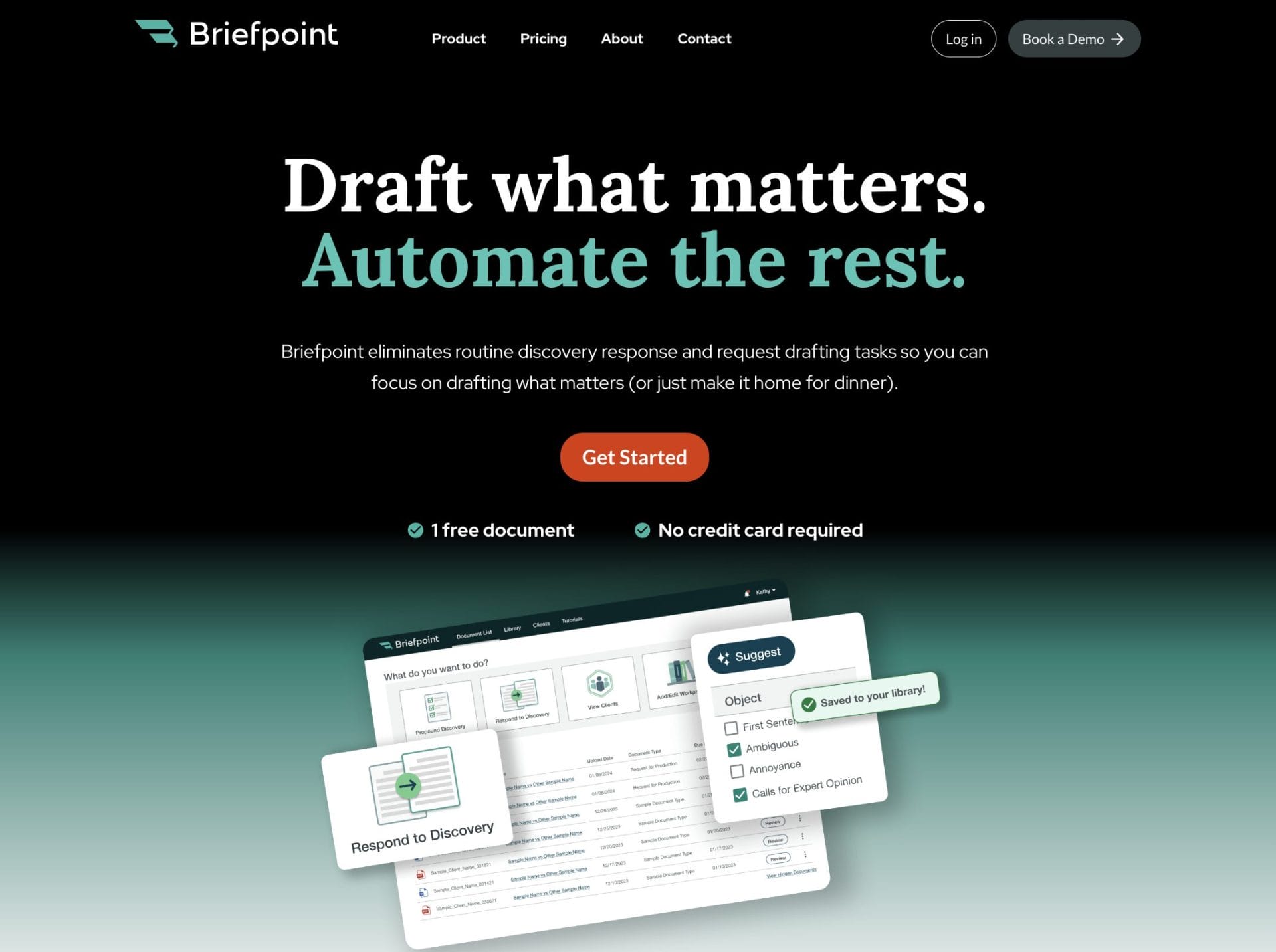
This legal drafting software is all about making your life easier by automating discovery response and request creation.
Instead of starting from scratch every time, you just upload your opposing counsel’s discovery request .pdf, and Briefpoint does the rest—creating a fully formatted, ready-to-use response document in no time.
Briefpoint also comes with a tool that makes collecting and incorporating client responses into discovery requests ten times faster.
With Briefpoint Bridge, you can select the interrogatories you want your client to answer, add notes to simplify the interrogatories or seek specific information, then send your client the link to the portal via email.
Once your client sends over their responses, you can easily amend and add them to your discovery request. No more back-and-forth emails!
Briefpoint lets you automate the creation of outgoing sets and responses to:
- Requests for Admission
- Requests for Production
- Interrogatories
Book your demo today and see how Briefpoint can take hours off your workflow!
2. OneDrive: Best Legal Document Management System
Managing legal documents can be a hassle, especially when dealing with a ton of files and trying to keep everything organized.
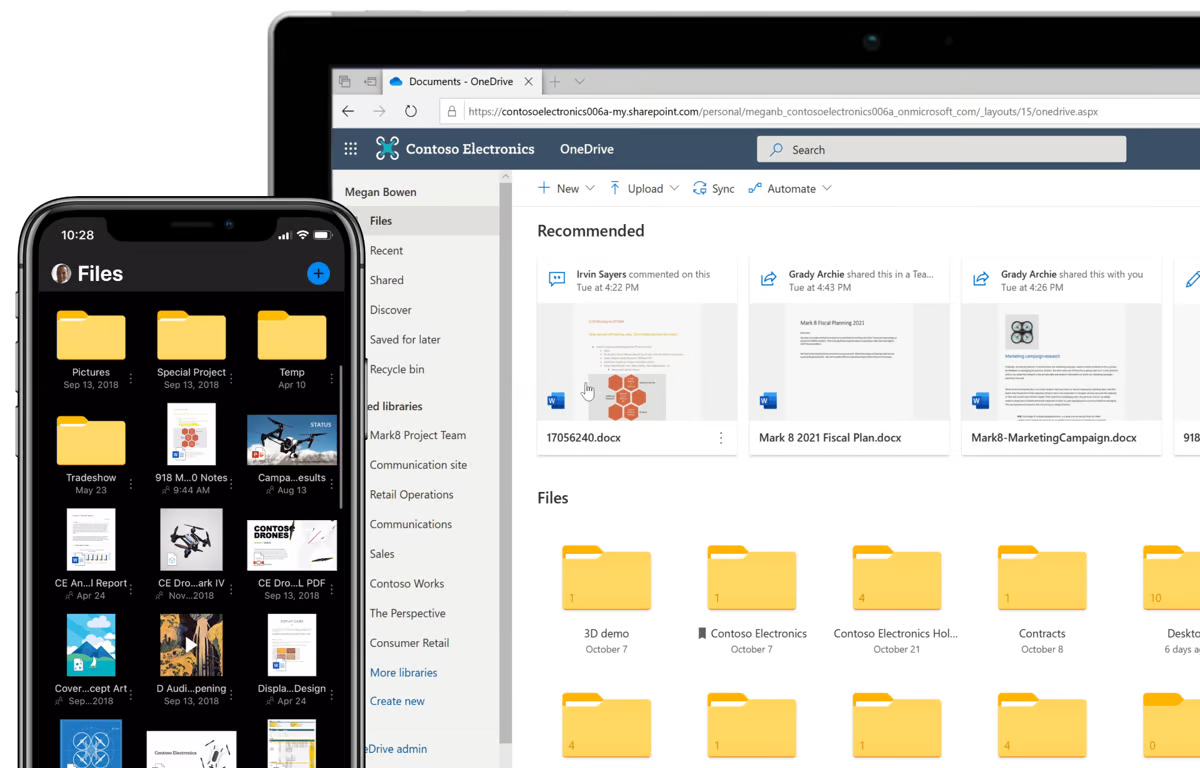
Source: G2
If you’ve ever found yourself wasting time searching for a missing document or stressing over whether you’re working with the right version, you know how frustrating it can be. OneDrive can change that.
It’s more than just cloud storage—it’s a tool designed to make document management easier and more efficient.
With OneDrive, you can quickly locate any document you need, thanks to its search features, and the version history makes sure you’re always working with the most current information.
The smooth Microsoft Office integration means you can edit documents seamlessly, all while knowing your files are securely stored.
3. Ironclad: Best for Contract Management
Contracts are the backbone of any legal practice, but keeping track of them can quickly become overwhelming. Juggling multiple drafts, managing approvals, and staying on top of deadlines can feel like a full-time job in itself.
If you find yourself in this situation, Ironclad is the best tool for you. Ironclad is specifically built to simplify contract management and offers a centralized platform where you can handle everything from drafting to execution.
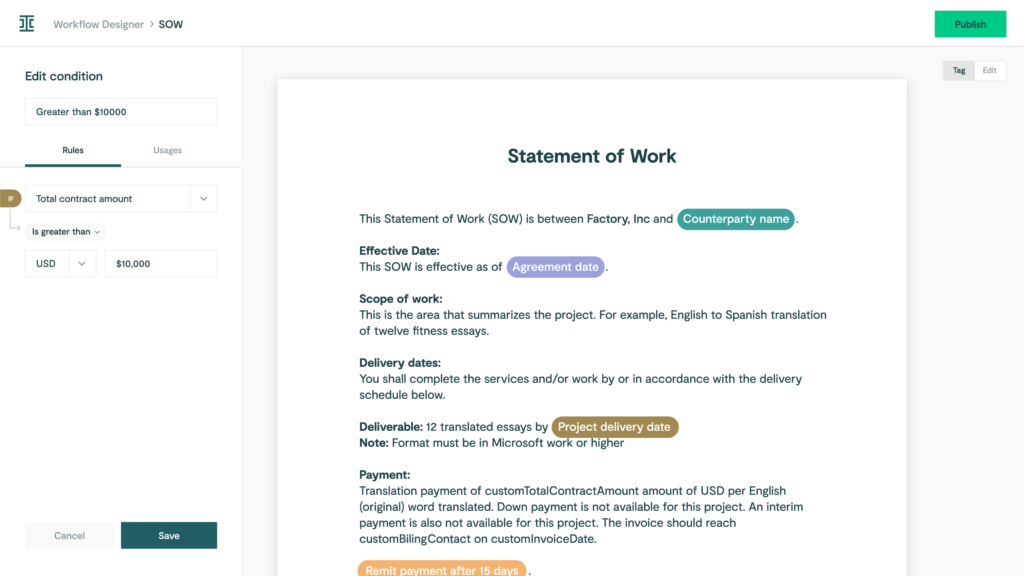
Source: G2
It lets you manage each stage of the contract lifecycle with ease so that every version is tracked and every deadline is met.
Ironclad also simplifies collaboration, which makes it simple to work with colleagues and clients without the usual back-and-forth confusion.
Instead of getting bogged down in the details, Ironclad helps you stay organized and in control so you can manage your contracts with confidence and efficiency.
4. DocuSign: Best for Electronic Signatures
Any law office knows that waiting on physical signatures can slow everything down. Whether you’re finalizing a contract or getting an agreement in place, the last thing you want is to be held up by paperwork.
That’s why DocuSign is such a must-have for law firms. It transforms the signing process into something seamless and straightforward. Instead of printing, mailing, or scanning, DocuSign lets you send documents for electronic signatures instantly.
Source: G2
The platform is user-friendly and secure, giving you peace of mind that the signatures are legally binding and the process is fully tracked.
5. Clio: Best Legal Practice Management Software
Managing a law practice involves handling a lot of different tasks—tracking cases, managing client communications, handling billing, and keeping everything on schedule. Without the right law practice management software, it can quickly become overwhelming.
Clio is designed to combine all these elements into one cohesive platform tailored specifically for legal professionals. With Clio, you can easily manage your cases, track billable hours, send invoices, and organize client communications all in one place.
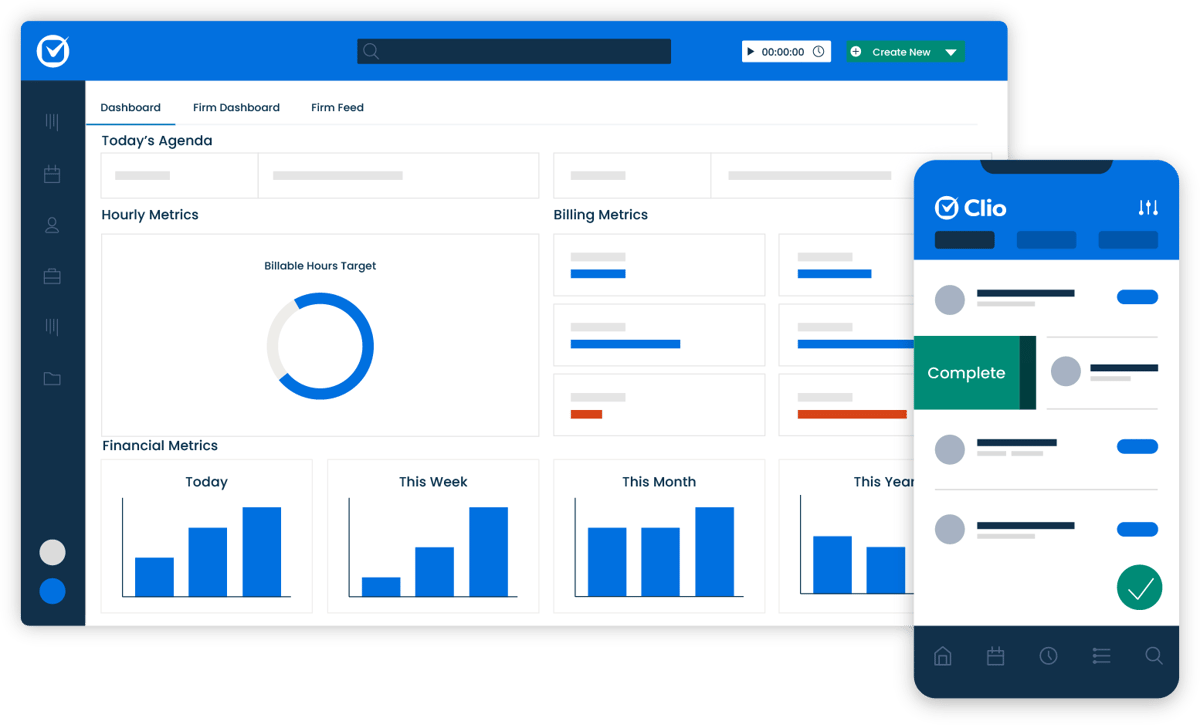
Source: G2
Plus, the software’s user-friendly interface makes sure that you can stay on top of your workload and maintain order, even during the busiest times.
Clio also offers seamless integrations with other tools, which allows you to customize it to meet the specific needs of your law firm.
Best Practices for Creating, Storing, and Organizing Legal Documents
When it comes to handling legal documents, a little organization can go a long way in making your life easier and keeping things running smoothly.
Here are some straightforward practices that can help you create, store, and organize your legal documents a hundred times better:
Opt for Paperless Document Management
If you’re still dealing with stacks of paper, it’s time to consider going paperless. Digital documents are easier to organize, search, and share, especially with the right document management tool.
Plus, going paperless reduces the risk of losing important paperwork and makes your office more environmentally friendly.
Scanning and saving all your documents electronically can also smoothen out your legal workflow and make everything more accessible.
Use Consistent Document Templates
Starting with a blank document each time is time-consuming and increases the likelihood of errors.
Using standardized templates makes sure all your documents have a consistent format, which is a must in the legal industry where precision matters.
Develop a Clear Naming Convention
A clear naming system for your files is key to staying organized. Include details like the client’s name, document type, and date in your file names to quickly identify what each document contains without opening it. This simple step can save you a lot of time.
Organize Documents with a Logical Folder Structure
With your legal document management solution, set up a folder structure that makes sense for your practice. Group documents by client, case, or matter and create subfolders for different types of documents like contracts, correspondence, and briefs.
A well-organized folder system helps you find what you need quickly so you can stay focused on your work.

Back Up Your Files Regularly
Losing important legal documents can be disastrous, so regular backups are a must. Cloud storage solutions like OneDrive are great for automatic backups, and it’s wise to keep an additional offline backup as a precaution. This helps make sure your files are safe and accessible, even if something goes wrong.
It might also be a wise idea to invest in unlimited document storage so you won’t have to worry about running out of space.
Keep Track of Version Control
When documents go through multiple revisions, it’s easy to lose track of changes.
Version control allows you to monitor edits, revert to previous versions, and make sure that everyone is working with the latest document. This is especially useful in collaborative environments.
Secure Sensitive Information
Legal documents often contain sensitive information that must be protected. Use encryption, strong passwords, and access controls to safeguard your files. Regularly review and update your security protocols to keep your documents safe from unauthorized access.
Follow Document Retention Policies
Having a clear policy for how long to keep your law firm’s documents is important for managing storage and staying compliant with legal regulations.
Make sure your retention policies are up to date and regularly reviewed to meet current standards.
Train Your Team
Finally, see to it that everyone on your team understands and follows your document management practices.
Regular training sessions can help reinforce these best practices and keep your document management system running smoothly.
How Much Does Legal Document Software Cost?
The cost of legal document software can vary quite a bit depending on what you need and the size of your firm. Here’s a breakdown of what you might expect:
- Basic options: If you’re just looking for something simple to manage your documents, you might find software that costs around $10 to $50 per user per month. This usually covers the basics like storage, search, and version control.
- Mid-range solutions: For those who need a bit more, like legal automation, integrations with other legal tools, or better security, you’re probably looking at something in the $50 to $100 per user per month range. This is ideal for mid-sized firms that need more than just the basics.
- All-in-one systems: If you’re looking for a comprehensive solution that includes document management, case management, billing, and client communication, the cost can go up to $100 to $200+ per user per month. These systems are great for larger firms that need a full suite of tools.
- Enterprise-level software: For very large firms with complex needs, enterprise-level software might be necessary, which can run $200 to $500+ per user per month. These solutions often include advanced features like AI-driven analytics and extensive integrations.
Speaking of AI, if you’re looking at software with AI capabilities—such as AI-driven document drafting, predictive analytics, or automated contract reviews—expect the cost to be on the higher end.
Legal AI features can significantly raise the price because they offer powerful tools that can save time and improve accuracy, but they also come with a premium cost. So, if AI is on your must-have list, be prepared for a steeper investment.
Spend Less Time on Routine Legal Drafting With Briefpoint
Managing legal documents doesn’t have to be a headache. With the right legal tech, you can turn time-consuming tasks into easy processes that free up more of your day for what really matters—serving your clients.
Whether it’s automating document creation, managing contracts, or keeping your files organized, the right tech stack can make all the difference.
Add Briefpoint to the very top of your legal tech tools list. If you want to stop spending hours drafting discovery documents, Briefpoint offers a smarter, faster process.
Imagine cutting down on time spent and saving your firm thousands per attorney each year—all while guaranteeing accuracy and consistency.
Ready to see how Briefpoint can revolutionize your workflow? Schedule a demo now and take the first step toward transforming how you handle legal documents!
How Much Can You Save With Briefpoint?
Discovery responses cost firms $23,240, per year, per attorney. $23,240 estimate assumes an associate attorney salary of $150,000 (including benefits – or $83 an hour), 20 cases per year/per associate, 4 discovery sets per case, 30 questions per set, 3.5 hours spent responding to each set, and 1800 hours of billable hours per year.
Book a demo and save on these costs with Briefpoint.
FAQs About Software for Legal Documents
What software do lawyers use?
Lawyers use a variety of software to manage their workload efficiently. This includes document automation tools for drafting legal documents, case management software for tracking deadlines and client information, and e-signature solutions for securely signing agreements. Popular choices include Clio, DocuSign, Briefpoint, and NetDocuments, each catering to different aspects of legal practice.
How do I create a legal document in Word?
You can start by using a built-in template or drafting from scratch. Microsoft Word offers pre-made templates for contracts, agreements, and other legal documents. Simply choose a template, fill in the necessary details, and customize it as needed. For a more efficient approach, document automation software can help generate legal documents quickly with pre-set templates and AI-powered drafting.
What is legal document management software?
Legal document management software helps law firms organize, store, and retrieve case-related documents efficiently. It provides secure storage, version control, and advanced search capabilities, ensuring that documents are easy to access and protected against unauthorized use. These tools eliminate the hassle of sifting through piles of paperwork and improve collaboration among legal teams.
Which is the best document control software?
The best document control software depends on your firm’s needs. Options like NetDocuments, iManage, and Clio are widely used for their security, cloud storage, and collaboration features. If you’re looking for an AI-powered tool to streamline discovery responses, Briefpoint offers a specialized solution for automating legal drafting, cutting down the time spent on routine paperwork.
The information provided on this website does not, and is not intended to, constitute legal advice; instead, all information, content, and materials available on this site are for general informational purposes only. Information on this website may not constitute the most up-to-date legal or other information.
This website contains links to other third-party websites. Such links are only for the convenience of the reader, user or browser. Readers of this website should contact their attorney to obtain advice with respect to any particular legal matter. No reader, user, or browser of this site should act or refrain from acting on the basis of information on this site without first seeking legal advice from counsel in the relevant jurisdiction. Only your individual attorney can provide assurances that the information contained herein – and your interpretation of it – is applicable or appropriate to your particular situation. Use of, and access to, this website or any of the links or resources contained within the site do not create an attorney-client relationship between the reader, user, or browser and website authors, contributors, contributing law firms, or committee members and their respective employers.
5 Best Accounting Software For Small Law Firms (A 2025 Guide)
5 Best Accounting Software For Small Law Firms (A 2025 Guide)
Keeping a small law firm financially stable takes more than just landing new clients.
Late payments, trust accounting mistakes, and disorganized records can lead to compliance issues and cash flow problems. Without the right system, even simple bookkeeping tasks can turn into unnecessary headaches.
That’s why many firms turn to legal accounting software. Instead of juggling spreadsheets or using a generic accounting tool that doesn’t fit your needs, these platforms help track billable hours, manage trust accounts, and keep finances in order.
Let’s break down the best accounting software options for small law firms and how they can help.

What is Law Firm Accounting Software?
Law firms don’t just need accounting software—they need tools built for the way legal finances work. Between managing trust accounts and staying compliant with industry regulations, standard bookkeeping software doesn’t always cut it.
Legal accounting software helps firms handle client funds properly, generate accurate invoices, and keep financial records organized without extra manual work. Many tools also integrate with case and law practice management software, making it easier to connect billing with legal work.
The key difference? It’s designed to keep law firms compliant and efficient. With built-in trust accounting, expense tracking, and reporting tools, it reduces the risk of errors and helps firms stay on top of their finances without getting lost in spreadsheets.
What Do Small Law Firms Have to Consider When Choosing Accounting Software?
Small law firms have different accounting needs than large firms. You don’t have a full finance team handling the books, so the software you choose has to be practical, compliant, and easy to use. Here’s what to consider:
- Trust accounting compliance – You’re responsible for client funds, and trust accounting mistakes can lead to serious issues. The software should properly track, separate, and reconcile trust accounts.
- Billing & invoicing – If your system doesn’t make it easy to log billable hours and send invoices, you could be leaving money on the table. Look for automated invoicing and payment tracking.
- Cost & scalability – Budgets are tight, and you don’t want to overpay for features you won’t use. But as your firm grows, you’ll need software that can keep up.
- Integration with legal tools – If your accounting software doesn’t sync with your case management system, you’ll spend extra time on manual data entry.
- User-friendliness – You don’t have time to struggle with complex software. A clean, intuitive interface is key.
- Reliable support – When problems arise, fast and knowledgeable customer service makes all the difference.
What Are The Biggest Benefits of Using Legal Accounting Software?
Do you ever feel like managing your firm’s finances takes up more time than actual legal work? Tracking billable hours, handling trust accounts, and chasing down invoices can be overwhelming—especially if you’re relying on spreadsheets or generic accounting tools.
The right legal accounting software keeps everything in check and helps your firm run more smoothly. Here’s how:
Trust Accounting Without the Headaches
Handling client trust accounts isn’t just another task on your to-do list—it’s a responsibility you can’t afford to get wrong. A single mistake can lead to compliance issues, penalties, or even worse.
A good legal accounting software solution takes the guesswork out of trust accounting by automatically keeping client funds separate, tracking every transaction, and generating audit-ready reports.
This means no more manual spreadsheets or worrying about whether your records are accurate. With clear trust ledgers and built-in safeguards, you can stay compliant and focus on your legal work instead of stressing over financial details.
Easier Billing and Faster Payments
Getting paid shouldn’t be a struggle. If you’re still manually tracking hours, creating invoices from scratch, and following up on late payments, you’re spending way too much time on admin work.
Legal accounting software makes billing easier by:
- Automatically logging billable hours
- Generating invoices
- Sending payment reminders
Clients can pay online without hassle, and this means fewer delays and keeping your cash flow steady. Instead of chasing payments or dealing with messy records, you’ll have a system that keeps everything organized.
Fewer Manual Errors
Ever caught a mistake in your books and thought, How did that even happen?
Maybe a decimal was off, a duplicate entry slipped in, or a trust account transaction didn’t balance. Manual data entry makes errors almost inevitable—and fixing them takes time you don’t have.
Legal accounting software helps prevent these slip-ups by automating calculations, tracking every transaction, and flagging inconsistencies before they turn into real problems. So, instead of double-checking numbers and fixing avoidable mistakes, you get clean, accurate records from the start.
Better Cash Flow Management
Late payments and untracked expenses can throw off your firm’s finances fast. If cash flow is unpredictable, it’s harder to plan for growth, cover expenses, or even pay yourself consistently.
The right legal billing software gives you real-time visibility into where your money is coming from—and where it’s going—so you can stay ahead of financial issues before they become bigger problems.
Here’s how it helps:
- Track unpaid invoices – See outstanding balances at a glance and send automated reminders to speed up payments.
- Monitor firm expenses – Keep an eye on operational costs so nothing eats into your profits unnoticed.
- Plan ahead with better forecasting – With real-time financial data, you can make informed decisions about hiring, investments, and budgeting.
- Avoid cash flow surprises – No more guessing whether your firm’s financial performance is enough to cover upcoming expenses.
Seamless Integration with Case Management
Tired of entering the same data twice? Manually linking invoices to cases? Jumping between systems just to get a clear financial picture? That’s the problem when accounting and case management don’t work together.
Good legal accounting software connects with your case management system and keeps financial records aligned with client work automatically. No more double data entry, missing transactions, or wasted time fixing errors.
With everything in sync, billing runs smoother, financial reporting capabilities improve, and client management stays organized. Rather than wrestling with spreadsheets, you get a clear, accurate view of your firm’s finances—without the extra hassle.
Less Time Spent on Admin Work
Nobody starts a law firm because they love bookkeeping. But if you’re spending more time tracking expenses and preparing tax reports than actually practicing law, something’s got to change.
Legal accounting software takes those tedious tasks off your plate. It automatically tracks expenses, syncs with your bank for easy reconciliations, and organizes tax records without the last-minute scramble (and that’s just the tip of the iceberg).
Instead of drowning in spreadsheets or trying to fix accounting mistakes at the end of the month, you can focus on your clients and casework.
Best Accounting Software For Small Law Firm Operations
Now that we’ve covered the key benefits, it’s time to look at the best options. Not all accounting tools are designed for law firms, and choosing the wrong one can lead to compliance issues and extra admin work.
Let’s break down the top accounting software for small law firms and what makes them worth considering.
1. QuickBooks
QuickBooks is one of the most widely used accounting tools for small businesses, and law firms are no exception. With options like QuickBooks Online, QuickBooks Desktop, and QuickBooks Desktop Pro, firms can choose a plan that fits their needs.
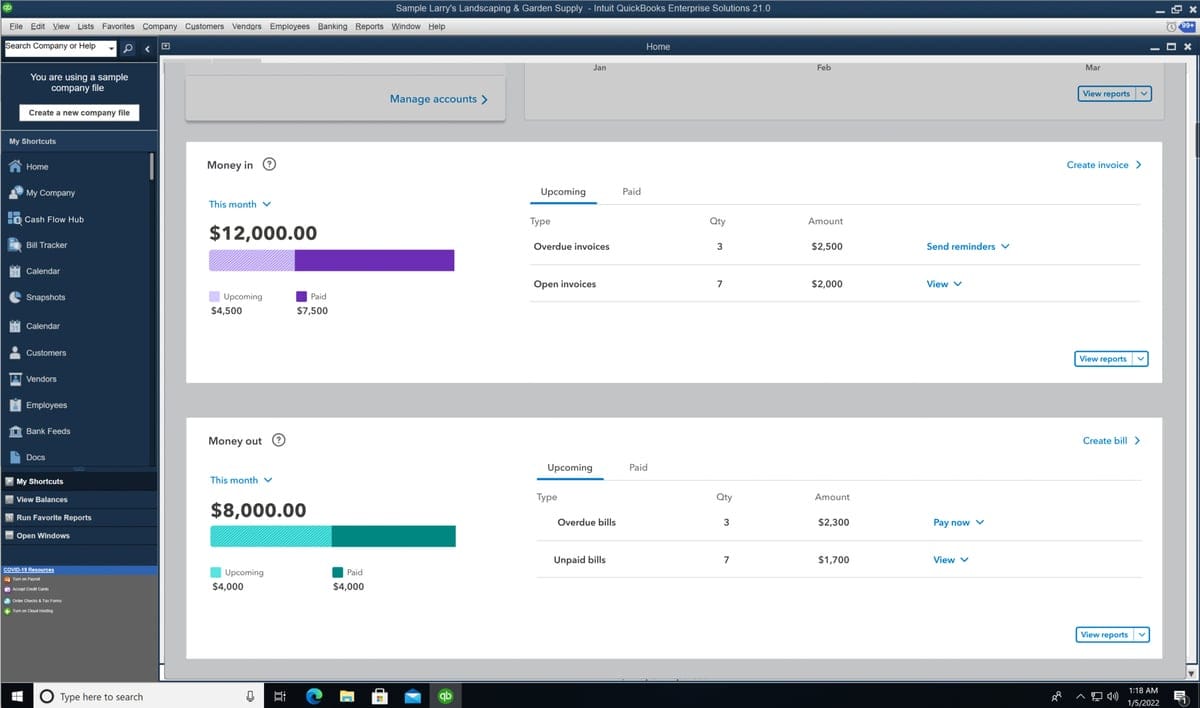
Source: G2
While it’s not built specifically for legal professionals, it offers powerful financial management features and integrates with legal software like Clio and LeanLaw.
Whether you need cloud-based access, advanced reporting, or simple bookkeeping, QuickBooks has a version that can handle your firm’s accounting needs.
Best Features
- Customizable invoicing: Create and send professional invoices, track payments, and accept online payments.
- Expense tracking: Automatically categorize expenses and reconcile bank transactions.
- Trust accounting support: Integrate with LeanLaw or Clio to properly manage client trust funds.
- Financial reporting: Generate profit and loss statements, balance sheets, and tax reports.
- Legal software integration: Sync with Clio, LeanLaw, and other law firm tools for seamless accounting.
Pros
- Easy to use and widely recognized
- Strong reporting and financial tracking
- Syncs with banks, payroll, and law firm tools
- Multiple versions available for different business needs
- Cloud-based access for remote accounting
- Scalable plans for growing firms
Pricing
The starting price for QuickBooks is €9.50 for the Simple Start plan. It comes with basic accounting essentials, such as invoices, receipt capture, income and expenses, and more. For teams, the Essentials Plan starts at €13.50, coming with more features and three user spots.
2. Clio Accounting
Clio Accounting is designed specifically for law firms, which makes it easier to manage trust accounting, billing, and financial reporting while staying compliant.
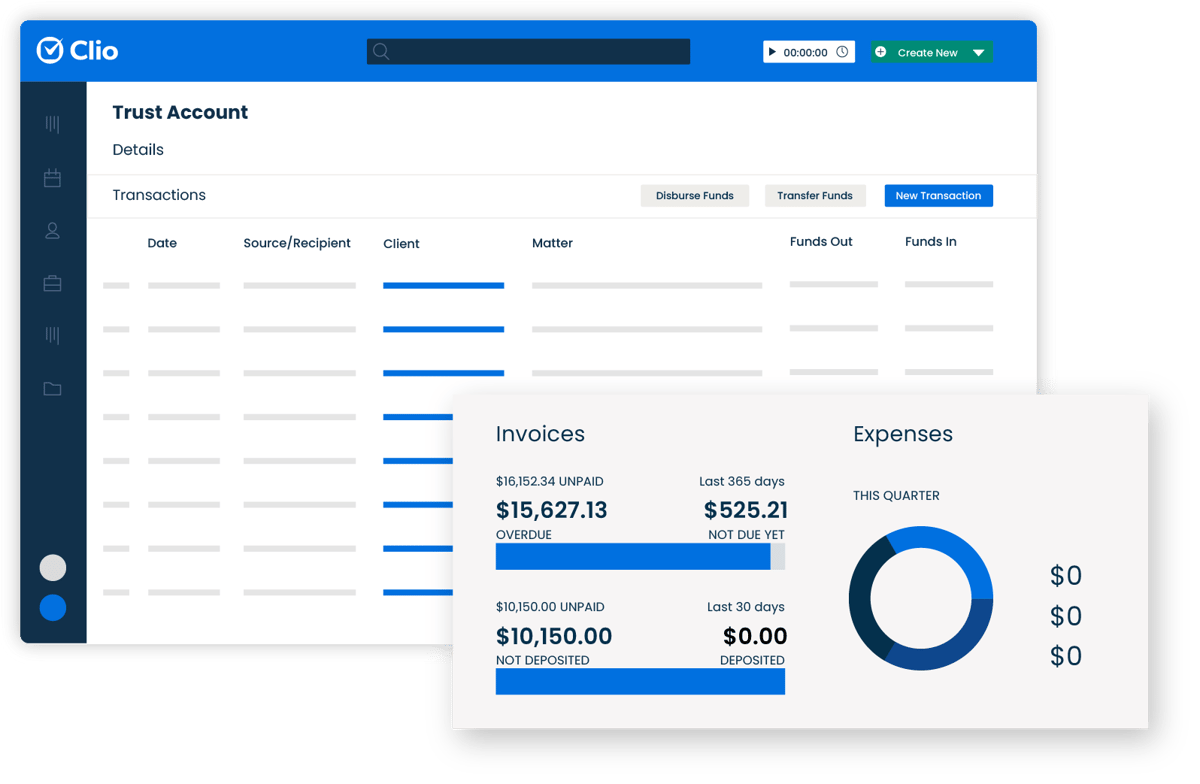
Source: G2
As part of the Clio ecosystem, it integrates with Clio Manage, allowing firms to track billable hours, generate invoices, and handle trust accounts all in one place.
Unlike general accounting software, Clio Accounting is built with legal professionals in mind. This can help reduce the risk of compliance issues and manual errors.
Best Features
- Trust accounting compliance: Keeps client funds separate and generates reports to meet legal industry regulations.
- Automated invoicing: Create and send professional invoices with built-in time tracking.
- Payment processing: Accept online payments through Clio Payments, reducing delays.
- Expense tracking: Log and categorize firm and client expenses effortlessly.
- Easy integration with Clio Manage: Syncs billing and accounting data with your case management system.
Pros
- Built specifically for law firms
- Strong trust accounting features
- Fully integrates with Clio’s legal management tools
- Cloud-based access for anytime, anywhere financial management
- Automated reminders help reduce late payments
- Reduces manual data entry by syncing with case files
Pricing
Clio Accounting is an optional add-on, available for the Essentials Plan and up. The starting price for the Essentials Plan is $89 per user per month.
3. LeanLaw
LeanLaw is built specifically for law firms that want seamless integration with QuickBooks while maintaining compliance with legal accounting rules.
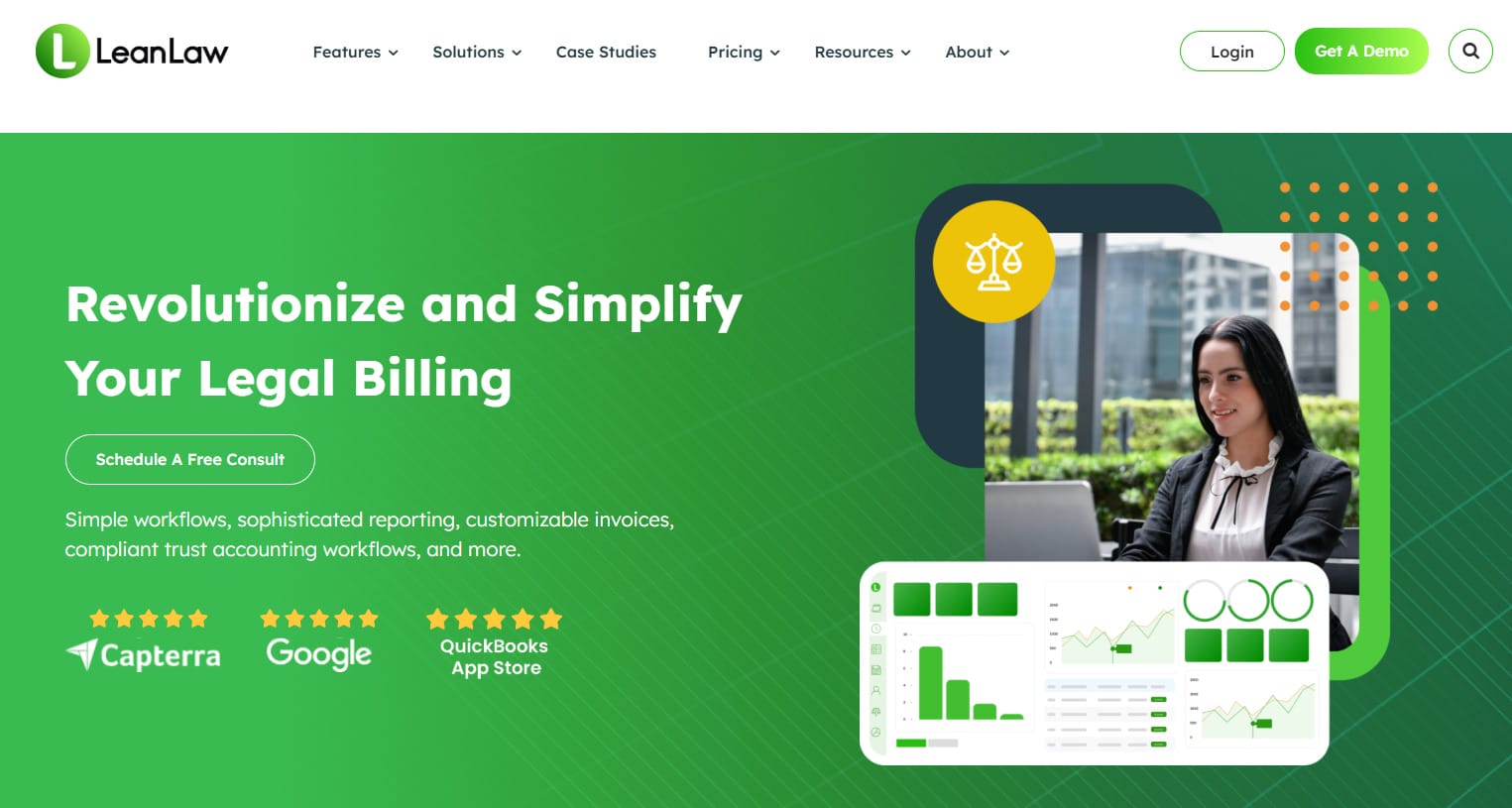
Source: LeanLaw.co
It simplifies trust accounting, time tracking, and billing, making it a great choice for firms that rely on QuickBooks but need legal-specific features. With an easy-to-use interface and strong financial reporting, LeanLaw helps small law firms manage their books without extra complexity.
Best Features
- Deep QuickBooks integration: Syncs directly with QuickBooks Online for smooth accounting workflows.
- Trust accounting compliance: Helps keep client funds separate and generates audit-ready reports.
- Time tracking & invoicing: Logs billable hours and turns them into invoices with a single click.
- LEDES billing support: Exports invoices in LEDES format for firms working with corporate clients.
- Expense tracking: Categorizes and assigns firm and client-related expenses easily.
Pros
- Designed specifically for law firms
- One of the best QuickBooks integrations available
- Simple and intuitive interface
- Helps prevent trust accounting errors
- Customizable reports for better financial insights
- Reduces manual data entry for time tracking and billing
Pricing
LeanLaw’s pricing starts at $45 per user per month for the Core Plan, which comes with features like time tracking, electronic payments, and invoicing.
4. FreshBooks
FreshBooks is a simple and user-friendly accounting solution for solo attorneys and small law firms that need straightforward invoicing, expense tracking, and timekeeping.
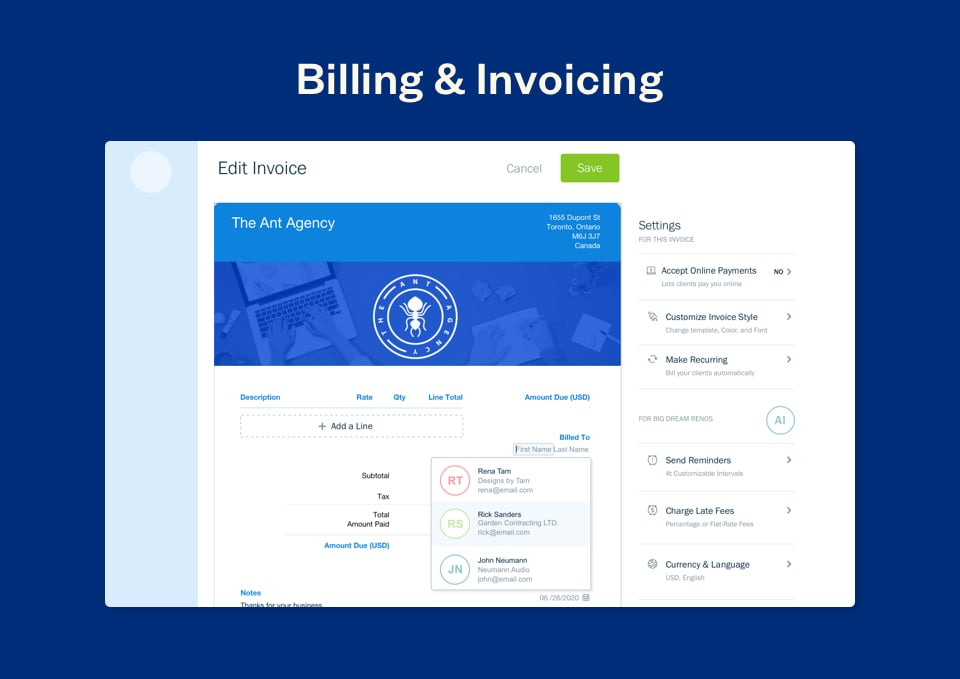
Source: G2
Although it’s not built specifically for law firms, its easy-to-use interface and automation features make financial management less time-consuming. It’s a good option for firms that don’t require complex trust accounting but need an efficient way to handle billing and expenses.
Best Features
- Automated invoicing: Create, send, and track invoices with built-in reminders for late payments.
- Time tracking: Log billable hours and convert them into invoices with one click.
- Expense management: Automatically track and categorize expenses for easier reporting.
- Online payments: Accept credit card and ACH payments directly through FreshBooks.
- Financial reporting: Generate profit and loss statements, expense summaries, and tax reports.
Pros
- Clean, easy-to-use interface
- Great for solo attorneys and small firms
- Automates invoicing and payment reminders
- Mobile-friendly for on-the-go access
- Affordable pricing compared to other options
Pricing
Plans start at $6.30 for the Lite plan, which allows users to send invoices to five clients, track expenses and other basic accounting work. More robust features are available in higher-tier plans, starting at $11.40 per month for the Plus plan.
5. Xero
Xero is designed for small businesses but offers key features that work well for law firms, including automated bank reconciliation, invoicing, and expense tracking.
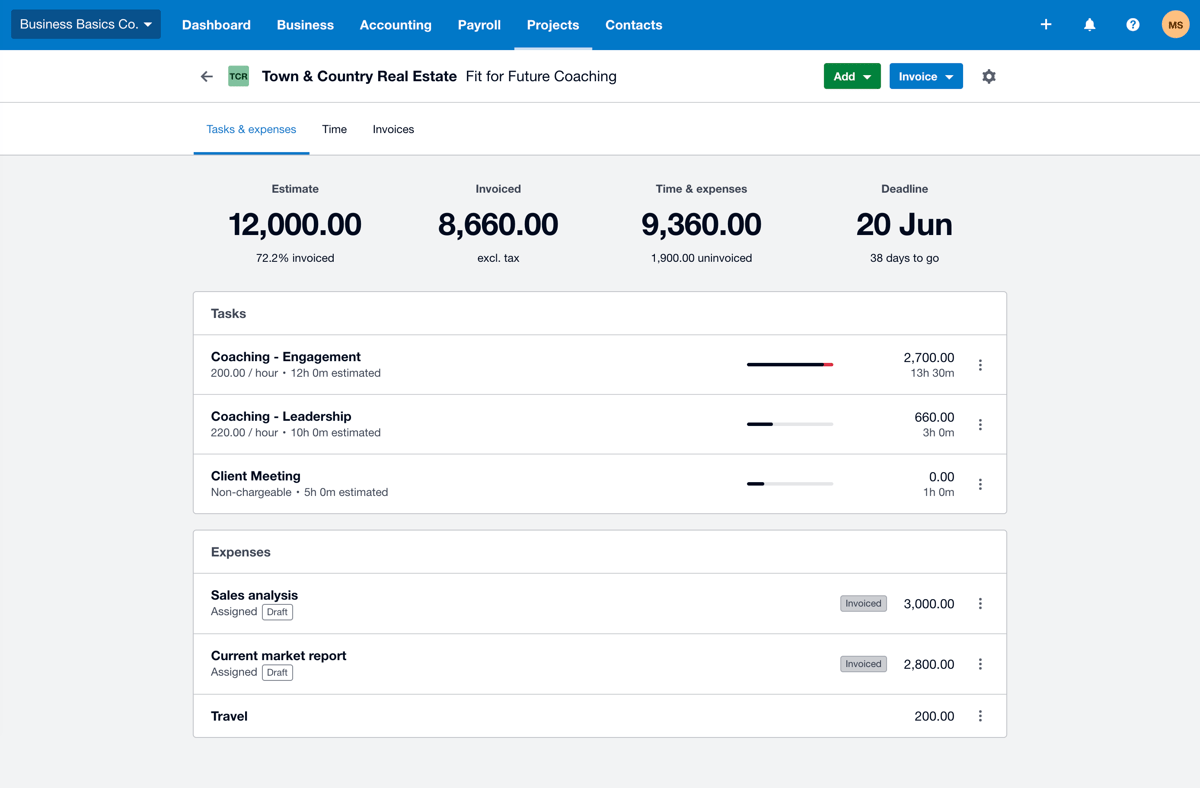
Source: G2
With real-time financial insights and multi-user access, Xero helps firms stay on top of cash flow without getting bogged down in spreadsheets. Plus, it integrates with legal practice management tools, which makes it easier to keep billing and accounting connected.
Best Features
- Bank reconciliation: Syncs with your bank to automatically track and match transactions.
- Customizable invoicing: Create and send branded invoices with automated payment reminders.
- Expense tracking: Categorizes and manages firm-related expenses for better financial oversight.
- Multi-user access: Allows accountants, bookkeepers, and partners to collaborate in real time.
- Financial reporting: Provides insights into cash flow, outstanding invoices, and overall firm performance.
Pros
- Affordable compared to other accounting tools
- Cloud-based for easy access from any device
- Integrates with legal management software like Clio
- User-friendly dashboard with real-time financial insights
- Strong security features to protect financial data
- Scalable for growing firms
Pricing
Xero’s Starter Plan costs $29 per month, which lets users send quotes and up to 20 invoices, enter five bills, reconcile bank transactions, and record bills and receipts.
Want to Beef Up Your Law Firm’s Cash Flow? Try Briefpoint
Keeping your firm’s finances in order isn’t just about choosing the right accounting software—it’s also about making the most of your time. Even the best accounting tools can’t fix cash flow problems caused by hours of unpaid admin work.
Briefpoint helps by automating legal drafting and generating discovery documents in minutes. This way, you can cut down the time spent on repetitive tasks and actually focus on billable work.
More billable hours mean more money in your bank accounts and keeping your firm financially stable. Instead of getting buried in paperwork, you’ll spend more time on high-value tasks that bring in revenue.
Want to see how much time—and money—you could be saving? Book your Briefpoint demo today.
Save Thousands Every Year With Briefpoint
Discovery responses cost firms $23,240, per year, per attorney. $23,240 estimate assumes an associate attorney salary of $150,000 (including benefits – or $83 an hour), 20 cases per year/per associate, 4 discovery sets per case, 30 questions per set, 3.5 hours spent responding to each set, and 1800 hours of billable hours per year.
Book a demo and save on these costs with Briefpoint.
FAQs About Accounting Software For Small Law Firms
What software do most law firms use?
Most law firms use a combination of legal-specific software for case management, billing, and accounting. Popular choices include Clio, LeanLaw, and QuickBooks (with legal integrations). Firms looking for a robust accounting platform often choose tools that offer trust accounting, invoicing, and financial reporting designed for legal compliance.
Does QuickBooks work for law firms?
Yes, but it requires legal-specific integrations to handle trust accounting properly. Many firms pair QuickBooks Online with tools like LeanLaw or Clio to ensure compliance with legal financial regulations.
What is CRM for law firms?
A law firm CRM (customer relationship management) system helps track client interactions, manage leads, and improve client communication. Unlike case management software, a CRM focuses on business development and client retention rather than legal workflows.
How much does law firm software cost?
Prices vary depending on the type of software and features included. Basic accounting tools like Xero start at $29 per month, while comprehensive legal platforms like QuickBooks and LeanLaw range from $35 to $45 per user per month. Advanced solutions with CRM and case management features can cost significantly more.
The information provided on this website does not, and is not intended to, constitute legal advice; instead, all information, content, and materials available on this site are for general informational purposes only. Information on this website may not constitute the most up-to-date legal or other information. This website contains links to other third-party websites. Such links are only for the convenience of the reader, user or browser. Readers of this website should contact their attorney to obtain advice with respect to any particular legal matter. No reader, user, or browser of this site should act or refrain from acting on the basis of information on this site without first seeking legal advice from counsel in the relevant jurisdiction. Only your individual attorney can provide assurances that the information contained herein – and your interpretation of it – is applicable or appropriate to your particular situation. Use of, and access to, this website or any of the links or resources contained within the site do not create an attorney-client relationship between the reader, user, or browser and website authors, contributors, contributing law firms, or committee members and their respective employers.
5 Best AI Software For Law Firms in 2025
5 Best AI Software For Law Firms in 2025
Artificial intelligence is changing the way law firms handle everyday tasks. Research, contract review, and discovery responses don’t have to eat up hours of your time anymore.
With the right AI tools, you can cut down on paperwork, reduce mistakes, and focus on the work that actually requires legal expertise.
And it’s not just a trend—72% of legal professionals say AI is making their jobs easier. Automating repetitive tasks helps keep cases moving, improves accuracy, and gives you back time for higher-value work.
In this guide, we’ll break down the best AI software for law firms, how it can help, and what you need to know to start using it.

The Integration of AI Into The Legal Industry
Legal work comes with a lot of paperwork, research, and long hours—but AI is helping lawyers cut down on the busywork.
Think about how much time gets spent reviewing contracts, searching for case law, or drafting the same types of documents over and over. AI tools can handle these tasks in minutes, flagging errors, pulling relevant legal precedents, and even organizing case files.
It’s also helping with billing, scheduling, and client communication. Some firms even use AI chat tools to handle basic client questions, so lawyers don’t have to spend time answering the same inquiries all day.
AI isn’t replacing attorneys, but it’s making legal work more efficient. Less time on routine tasks means more time focusing on cases—and maybe even finishing work at a reasonable hour.
What Are The Best AI Tools for Lawyers?
Not all AI legal tools are built the same, and let’s be honest—some just aren’t worth the hype. The best ones actually make legal work easier by handling contract drafting, case management, research, or compliance.
Whether you’re looking to cut down on paperwork, speed up research, or stay more organized, there’s an AI tool for that. Here are some of the best options to help your firm work smarter, not harder.
1. Briefpoint
Handling discovery responses is one of the most tedious parts of legal work, but Briefpoint makes it faster and easier.
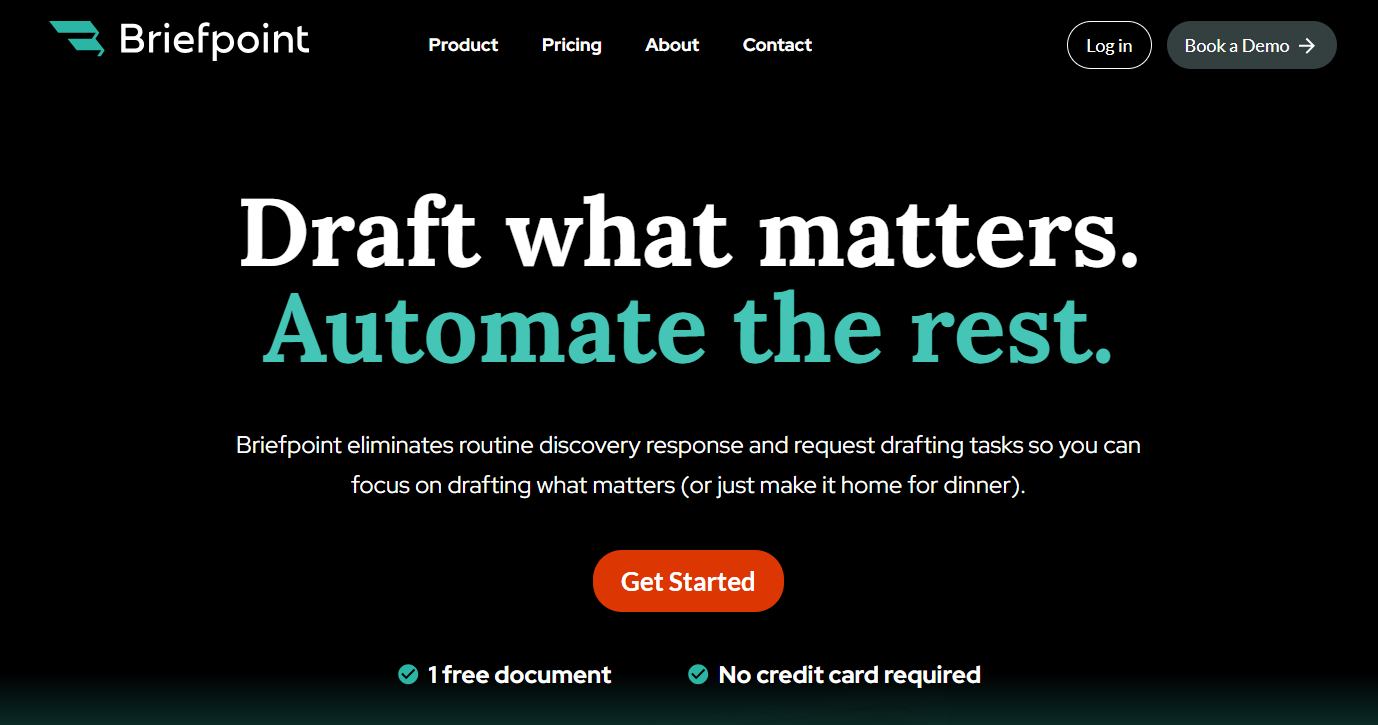
This AI-powered tool automates the drafting of discovery request and response documents. These include but are not limited to:
- Requests for production
- Requests for admission
- Interrogatories
That means you can cut down the time spent on formatting, organizing, and filling out routine details.
Instead of manually typing out responses, legal professionals can upload opposing counsel’s discovery requests, and Briefpoint’s AI system will generate structured, properly formatted responses in minutes.
Essentially, it’s designed to save time, reduce errors, and let attorneys focus on case strategy instead of a repetitive document review process.
If you want to see Briefpoint in action, book your free demo today!
Best Features
- Automated discovery responses: Converts opposing counsel’s requests into formatted responses, which cuts down on manual drafting.
- AI-powered data extraction: Automatically pulls key details like court names, case numbers, party names, and request types.
- Objection selection: Allows users to quickly add objections with a simple click instead of manually typing them.
- Word compatibility: Documents can be downloaded and opened in Word for final edits before filing.
- Supports multiple discovery documents: Works with Requests for Admission, Requests for Production, and Interrogatories across all U.S. state courts.
Pros
- Saves hours on discovery drafting by automating responses
- Ensures proper formatting and organization based on court rules
- Lets users add objections easily without manual typing
- Reduces errors by extracting key case details automatically
- Allows documents to be edited in Word, providing flexibility for final adjustments
- Speeds up the entire discovery process, making responses more efficient
2. Clio
Clio helps law firms stay organized by keeping everything—cases, billing, documents, and client communication—in one place. Instead of juggling multiple platforms, lawyers can manage deadlines, track time, send invoices, and collaborate with their teams from a single dashboard.
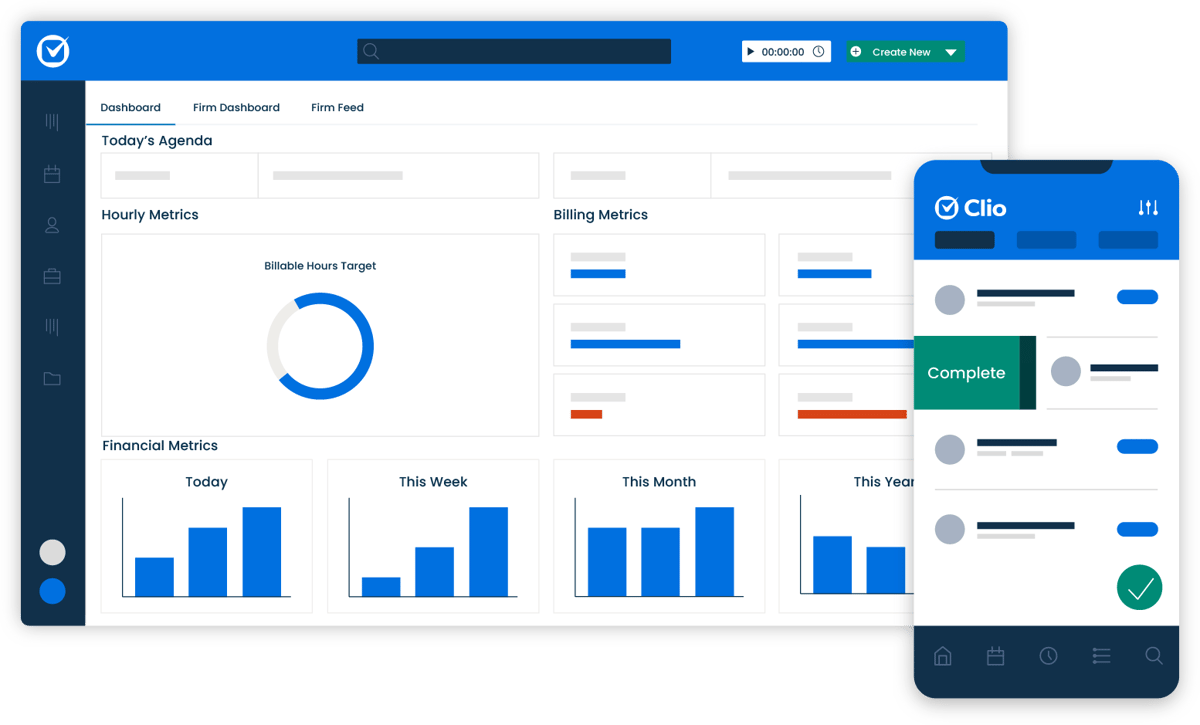
Source: G2
It’s a cloud-based solution, so you can access files from anywhere, whether you’re in the office or in court. With integrations for legal research, accounting, and productivity tools, Clio adapts to the way your firm works, making daily tasks easier and more efficient.
Best Features
- Case management: Keeps all case files, documents, and client details in one place for easy access.
- Billing & invoicing: Automates time tracking, generates invoices, and processes online payments.
- Client portal: Securely shares documents, messages, and case updates with clients.
- Document management: Stores and organizes contracts, pleadings, and discovery materials in the cloud.
- Integrations: Works with accounting, legal research, and productivity tools like QuickBooks, Google Drive, and Outlook.
Pros
- Simplifies case and billing management in one platform
- Allows secure client communication and document sharing
- Offers integrations with widely used legal and business tools
- Cloud-based, so lawyers can access files from anywhere
- Automates time tracking and invoicing to improve efficiency
Cons
- Higher pricing for premium features
- Some advanced tools require additional add-ons
- Learning curve for firms new to practice management software
Pricing
Clio offers four pricing plans based on firm needs. The EasyStart plan starts at $49 per user per month for basic case and document management. The Essentials plan at $89 per user per month adds time tracking and billing features.
The Advanced plan at $129 per user per month includes automation and advanced reporting, while the Complete plan at $159 per user per month offers full access to all features, including client intake and CRM tools.
3. Everlaw
Everlaw is an AI-driven e-discovery platform built to make litigation and investigations easier to manage.
Legal teams deal with massive amounts of documents, and sorting through them manually takes up valuable time. Everlaw speeds up the process with advanced search, machine learning, and collaboration tools, which help lawyers find key information faster.
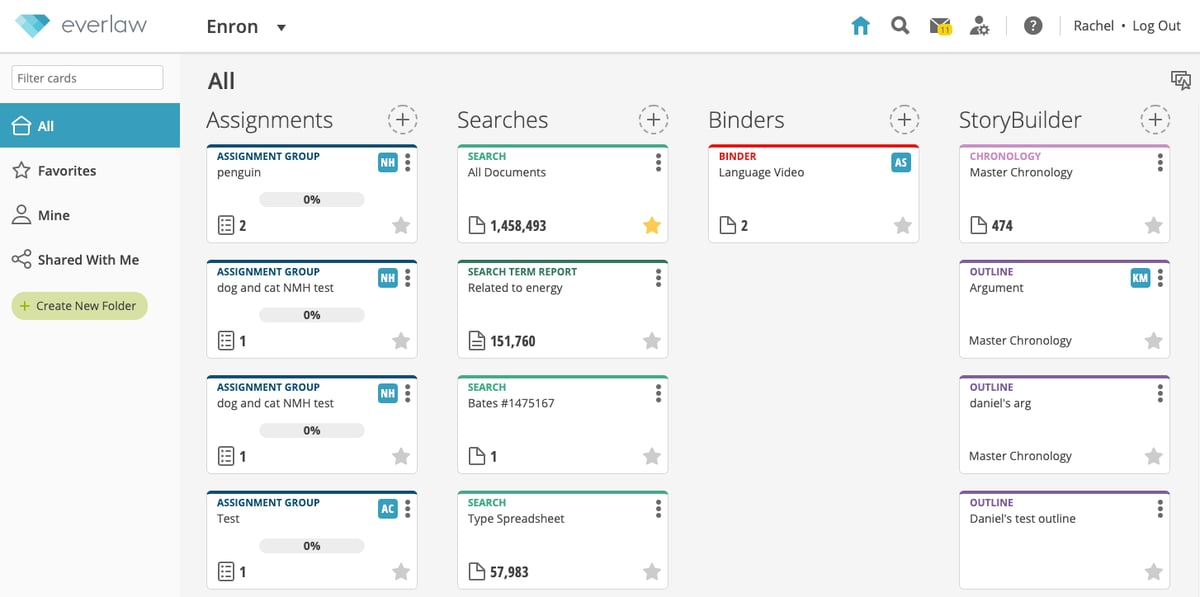
Source: G2
It also makes organizing evidence and preparing for trial more efficient. Since it’s cloud-based, teams can access case files from anywhere, whether they’re in the office, in court, or working remotely.
Best Features
- AI-powered search & review: Quickly scans and categorizes large volumes of legal documents to help lawyers find relevant information faster.
- Collaborative case building: Allows teams to organize evidence, manage timelines, and prepare for trial in a shared workspace.
- Integrated trial preparation: Includes tools for drafting arguments, managing depositions, and strategizing case presentations.
- Cloud-based access: Work on cases from anywhere without worrying about software updates or security risks.
Pros
- Speeds up document review with AI-powered search
- Simplifies collaboration by keeping all case materials in one place
- Provides unlimited training and support at no extra cost
- Frequent updates make sure the platform stays up to date
- Cloud-based, so teams can access files from anywhere
Cons
- Some advanced features have a learning curve
- Requires a stable internet connection to access all tools
- Pricing details aren’t publicly available
Pricing
Everlaw’s pricing is currently not publicly available.
4. Harvey
Harvey is a generative AI tool designed to help lawyers with research, drafting, and contract analysis.

Source: Harvey.ai
Instead of spending hours manually reviewing documents or searching for case law, legal teams can use Harvey to generate responses, analyze contracts, and answer complex legal questions in seconds.
It uses natural language processing (NLP) to understand legal terminology, which makes it useful for everything from litigation support to regulatory compliance. With multilingual and jurisdictional support, this AI legal software is also built to assist firms handling local cases or international legal matters.
Best Features
- AI-powered drafting and analysis: Generates and revises complex legal documents with accurate citations. This helps reduce the time spent on manual drafting.
- AI-powered legal research capabilities: Provides precise answers to intricate legal, regulatory, and tax questions.
- Secure document management: Allows firms to upload, store, and analyze large volumes of documents within a secure environment.
- Microsoft Word integration: Lets users generate and edit legal documents within Word, which helps keep the drafting process familiar.
- Multilingual and jurisdictional support: Works in over 50 languages and adapts to different legal systems, making it useful for international firms.
Pros
- Automates routine tasks, freeing up time for lawyers to focus on case strategy
- Uses NLP to understand legal context, improving accuracy in research and analysis
- Works within existing legal workflows, making adoption easier
- Regular updates make sure it stays aligned with legal developments
- Scales well for firms of all sizes, from solo practitioners to large enterprises
Cons
- Requires initial setup and training for teams to fully utilize its features
- Handling sensitive legal data requires strong security protocols
- AI-generated legal content still needs human oversight for accuracy
- Some firms may experience integration challenges with existing systems
Pricing
Harvey currently doesn’t have public pricing on their website.
5. DocuSign CLM
Managing contracts can be a headache, but DocuSign CLM (Contract Lifecycle Management) simplifies the process. It automates tasks like document creation, approval workflows, and storage, which makes it easier to handle contracts from start to finish.

Source: G2
Whether you’re closing deals or purchasing supplies, DocuSign CLM helps speed things up and reduces risks.
Best Features
- Automated document generation: Create contracts quickly using templates and a clause library.
- Streamlined workflows: Automate approval processes and track changes so everyone stays on the same page.
- Centralized storage: Keep all your contracts in one secure place, making it easy to search and retrieve documents.
- Integration capabilities: Works seamlessly with tools like Salesforce and SAP, connecting contract management with your existing systems.
- Risk mitigation: Standardize processes to minimize errors and maintain compliance.
Pros
- Automation speeds up contract creation and approval
- Teams can work together more effectively with shared access and real-time updates
- Suitable for businesses of all sizes, from startups to large enterprises
- Intuitive design makes it easy for users to navigate and manage contracts
Cons
- New users may need time to familiarize themselves with all the features
- Some systems may require additional setup for seamless integration
- As a cloud-based solution, a stable internet connection is necessary
- Highly specialized contract processes might need additional customization beyond standard offerings
Pricing
DocuSign doesn’t list the pricing for its CLM tool.
How to Integrate AI Into Your Legal Practice
Bringing AI into your legal profession doesn’t mean replacing lawyers—it means working smarter. Whether it’s cutting down on paperwork or making legal research faster, the right AI tools can make a big difference.
That said, we’ve compiled some tips on how to make the transition smoother:
- Pinpoint the bottlenecks. What’s eating up the most time? If research, document drafting, or client intake slows things down, AI can take over those repetitive tasks.
- Find the best legal AI tools. There’s no one-size-fits-all solution. Some legal AI solutions focus on contract review, while others assist with case management or billing. Choose what fits your firm’s workflow.
- Start with an AI assistant. Instead of diving in headfirst, test an AI assistant for specific tasks, like summarizing case law or generating first drafts of legal documents.
- Get your team on board: AI is only useful if people actually use it. Provide training and show how it saves time instead of adding extra steps.
- Measure the impact: Track improvements in efficiency and accuracy. If something isn’t working, adjust your approach or explore different AI options.
How Can Legal AI Tools Benefit Lawyers?
Whether you’re managing a small practice or a large firm, AI can make legal work smoother and more efficient. Here’s how these tools can help.
Saves Time on Routine Tasks
Legal work involves a lot of repetitive tasks—document drafting, contract review, and legal research all take up valuable time. Luckily, AI can handle these in minutes. For example, it can:
- Summarize legal documents
- Schedule appointments
- Research legal clauses
- Prepare documentation
- Draft communications
But instead of spending hours on menial yet necessary tasks, AI lets lawyers focus on strategy and case analysis. For firms handling a high volume of cases, AI speeds up workflows and makes sure that deadlines aren’t missed.
Reduces Errors and Improves Accuracy
Even the most detail-oriented lawyers can miss something in a long contract or case file. It happens—especially when you’re working under tight deadlines. AI tools help by catching inconsistencies, flagging missing clauses, and cross-checking legal references.
They can scan thousands of pages in seconds, spotting risks that might go unnoticed in a manual review. This is a big deal in contract law, where a single misplaced word can cause legal trouble.
With AI handling the fine details, lawyers can feel more confident that everything is accurate before sending it off to a client or court.
Makes Case Management Easier
Keeping track of multiple cases can feel like a full-time job on its own. Court dates, deadlines, and client details end up buried in emails or spread across different files, making it way too easy to miss something important.
AI-powered case management systems help keep everything organized. They track deadlines, sort case files, and even send reminders when it’s time to file paperwork.
Instead of wasting time digging for documents, lawyers can pull up case histories, notes, and client messages in seconds.

Cuts Costs for Law Firms
Running a law firm isn’t cheap, and hiring extra staff for research, document prep, and case management only adds to the costs. AI helps firms cut expenses by automating these time-consuming tasks without lowering quality.
Rather than spending billable hours on routine work, lawyers can focus on high-value cases or take on more clients.
For example, a small firm using AI for contract review can save thousands per year by reducing the need for manual proofreading. This levels the playing field, which allows smaller firms to compete with larger ones without a huge support team.
Helps With Legal Research
Legal research takes up a huge chunk of time, but AI makes it faster and more efficient. Instead of manually digging through databases, lawyers can use AI-powered tools to pull relevant cases, statutes, and legal opinions in seconds.
Here’s how AI helps:
- Instant case searches – AI scans thousands of legal documents and pulls the most relevant information based on keywords or legal questions.
- Pattern recognition – Some AI tools highlight trends in case law so attorneys can build stronger arguments.
- Precedent tracking – AI identifies key rulings that might otherwise be overlooked, which helps make sure cases are backed by solid legal precedent.
- Faster summarization – AI can condense lengthy legal texts into key points, making it easier to review large amounts of information quickly.
Improves Client Communication
Clients expect quick responses, but lawyers can’t always drop everything to answer emails or take calls.
AI-powered chat tools can handle basic client inquiries, schedule consultations, and even collect initial case details. This keeps clients informed while freeing up attorneys for more complex legal services.
AI can also generate personalized updates so clients feel engaged without lawyers having to manually check in. By automating these small interactions, law firms improve client satisfaction while focusing their time where it’s needed most.
Leave The Grunt Work to Briefpoint’s Sophisticated AI System
Sick of spending hours on discovery responses? AI is making legal work easier, and Briefpoint helps take the hassle out of drafting and formatting. No more manually filling in the same details over and over—just upload your document, add your objections, and get a properly formatted response in minutes.
With Briefpoint, you can cut down on paperwork and focus on the real work—building strong cases and serving your clients. It’s quick, accurate, and built to handle discovery requests like a pro.
Want to see how it works? Book a demo today and see how much value Briefpoint can offer!
Let Briefpoint Help Pad Your Bottom Line
Discovery responses cost firms $23,240, per year, per attorney. $23,240 estimate assumes an associate attorney salary of $150,000 (including benefits – or $83 an hour), 20 cases per year/per associate, 4 discovery sets per case, 30 questions per set, 3.5 hours spent responding to each set, and 1800 hours of billable hours per year.
Book a demo and save on these costs with Briefpoint.
FAQs About AI Software For Law Firms
How is AI being used in law firms?
AI is helping law firms work more efficiently by handling research, contract analysis, and document drafting. Legal AI software can quickly review large volumes of legal documents, flag inconsistencies, and even suggest relevant case law. Some firms use AI-powered tools for discovery responses, while others rely on AI for billing, case management, and compliance tracking. AI is also improving client communication through chatbots that answer common legal questions and help with intake forms.
Which AI model is best for law?
There isn’t a one-size-fits-all answer, but large language models (LLMs) trained on legal data are among the most effective for law firms. Models like GPT-4 and custom-built legal AI models help with contract analysis, legal research, and document drafting. Some platforms train AI specifically for legal work, ensuring they understand legal terminology, jurisdictional differences, and case law references. The best choice depends on whether a firm needs AI for research, contract management, or litigation support.
What type of software do law firms use?
Law firms use a mix of case management, legal AI software, eDiscovery tools, and document automation platforms. Popular options include Clio for case management, Everlaw for litigation support, and Briefpoint for automating discovery responses. AI-powered research tools like Westlaw and Lexis+ AI help lawyers quickly analyze general legal data, while contract lifecycle management (CLM) software like DocuSign CLM streamlines contract creation and compliance.
Does Westlaw have an AI tool?
Yes, Westlaw Precision and Westlaw Edge both use AI to enhance legal research. These tools help lawyers find relevant case law faster by using natural language processing and predictive analytics. Westlaw AI-Assisted Research is designed to understand the legal context better than a standard keyword search, making it easier to locate precedents, statutes, and court opinions. Westlaw is one of the most widely used research platforms in law firms, offering AI-driven insights based on general legal data across multiple jurisdictions.
The information provided on this website does not, and is not intended to, constitute legal advice; instead, all information, content, and materials available on this site are for general informational purposes only. Information on this website may not constitute the most up-to-date legal or other information.
This website contains links to other third-party websites. Such links are only for the convenience of the reader, user or browser. Readers of this website should contact their attorney to obtain advice with respect to any particular legal matter. No reader, user, or browser of this site should act or refrain from acting on the basis of information on this site without first seeking legal advice from counsel in the relevant jurisdiction. Only your individual attorney can provide assurances that the information contained herein – and your interpretation of it – is applicable or appropriate to your particular situation. Use of, and access to, this website or any of the links or resources contained within the site do not create an attorney-client relationship between the reader, user, or browser and website authors, contributors, contributing law firms, or committee members and their respective employers.
Will AI Replace Paralegals?
Will AI Replace Paralegals?
If you’re a paralegal, you’ve probably heard the buzz about AI revolutionizing the legal practice. Maybe you’ve even wondered, “Is my job safe? Will AI replace paralegals?”
These are fair questions. AI tools handle legal research, contract review, and discovery faster than ever. Some firms are already using automation to cut down on routine tasks.
AI isn’t a replacement for the skills and experience that paralegals bring. It can scan documents, flag clauses, and organize data but doesn’t think critically or understand legal strategy.
Law firms still need professionals who can analyze, problem-solve, and communicate effectively with clients and attorneys.
Rather than replacing paralegals, AI is reshaping their work. Those who embrace it will have more opportunities, not fewer. So, what exactly is changing, and what does the future look like? Let’s get into it.

Overview of Paralegal Work
Paralegals play a key role in law firms, handling legal work that helps attorneys focus on bigger tasks. They aren’t lawyers, but they assist with research, document preparation, and case management. Their work keeps legal cases moving smoothly and makes sure everything is properly organized.
Here are some of the main tasks paralegals handle:
- Basic legal research
- Drafting legal documents
- Case management
- Discovery
- Client communication
- Court filings
Paralegals work closely with attorneys but can’t provide legal advice or represent clients in court. Their job is to handle the behind-the-scenes work that keeps cases running efficiently.
With AI and automation tools becoming more common, paralegals now have tech-driven solutions to speed up some of these tasks.
But even with AI handling routine work, law firms still rely on paralegals for accuracy, critical thinking, and legal expertise.
How Is AI Changing How Paralegals Work?
With legal AI tools, paralegals can work more efficiently and spend less time on manual processes. Here’s a closer look at how AI impacts different paralegal work areas.
Speeding Up Legal Research
Traditional legal research takes time. Before AI, paralegals and other legal professionals had to sift through case law, statutes, and regulations manually.
AI-powered research tools can scan vast databases in seconds, identifying relevant cases and summarizing key points. This reduces the hours spent searching for information, which allows paralegals to focus on analyzing results rather than just finding them.
However, AI doesn’t replace legal judgment—paralegals still need to verify findings, assess relevance, and apply legal reasoning. AI is a tool that speeds up the process, but it’s not a substitute for human expertise.
Automating Document Drafting
AI is making document creation easier by generating standard legal documents based on templates. Paralegals no longer have to draft routine contracts, NDAs, or discovery responses from scratch.
Instead, AI can pre-fill key sections, format documents properly, and suggest clauses based on previous cases. This saves time and reduces the risk of missing important details.
While AI-generated drafts still need review and customization, automation significantly cuts down on repetitive work. Paralegals can spend less time formatting and more time making sure documents meet legal standards.
Improving Discovery
Sorting through thousands of legal documents used to be a tedious process, requiring paralegals to review and categorize every file manually.
AI now makes e-discovery faster by automatically identifying relevant documents, flagging key terms, and organizing data sets. This means less time spent on document review and more focus on case strategy.
AI can also detect patterns and highlight inconsistencies, making it easier to spot critical information. However, paralegals are still needed to verify AI’s selections and make sure nothing important is overlooked.
Optimizing Contract Review
AI-powered contract analysis tools help paralegals quickly identify risks, missing clauses, and inconsistencies.
Instead of reading through pages of legal text, they can rely on AI to highlight key areas for review. This reduces the chances of errors and speeds up contract analysis.
AI can also compare contracts against past agreements for better consistency and compliance with legal requirements. While AI can flag issues, it doesn’t replace a paralegal’s judgment in negotiating terms or understanding context.
Reducing Administrative Work
AI also helps with scheduling, file management, and other administrative tasks that used to take up a large portion of a paralegal’s time.
Automated case management tools organize legal files, track deadlines, and even generate reminders for upcoming tasks. Some AI-driven chatbots can handle routine client inquiries, freeing up paralegals to focus on legal work.
While AI can reduce the workload, the legal industry still relies on paralegals to manage client interactions and oversee case details.
AI Won’t Replace Paralegals Completely
AI is making legal work faster, but it’s not kicking paralegals out of the picture. Sure, it can handle tasks like document drafting, legal research, and e-discovery, but there’s a lot it just can’t do. Paralegals bring human judgment, attention to detail, and critical thinking—things AI still struggles with.
Think of it this way: Legal work isn’t just about pulling up laws and filling in templates. It’s about understanding context, spotting risks, and knowing when something doesn’t look right.
Then there’s the human side of things. Clients don’t want to talk to a chatbot when they have legal concerns. They want a real person who listens, asks the right questions, and explains things clearly.
AI can scan contracts for missing clauses but won’t negotiate terms or pick up on subtle legal nuances like a trained paralegal. As many legal professionals know, legal issues aren’t always straightforward. Every case is different, and sometimes, you just need a human to figure things out.
Instead of replacing paralegals, AI is becoming another tool in their arsenal. The ones who learn how to use it will have an edge, working smarter and faster. Law firms aren’t getting rid of paralegals—they’re just giving them better tech to work with.
So, What Does the Future Look Like for Paralegals?
AI is definitely transforming the legal profession, and entry-level paralegals will probably feel it the most.
A lot of the routine tasks—like document review, legal research, and basic contract drafting—are now automated. Law firms looking to cut costs might lean on AI for these instead of hiring as many junior paralegals.
But, that doesn’t mean human paralegals are going away. The role is just changing. Firms still need experienced paralegals to manage AI tools, double-check AI-generated documents, and handle complex legal work.

Things like spotting legal risks, communicating with clients, and making judgment calls? AI isn’t taking over those anytime soon.
Paralegals who learn how to work with AI will have an edge. Instead of getting buried in repetitive tasks, they’ll have more time for legal analysis, case strategy, and working directly with attorneys.
AI might handle the grunt work, but law firms will always need sharp, adaptable paralegals who know how to put the pieces together.
How Can Paralegals Future-Proof Themselves?
The presence of AI doesn’t mean paralegals have to take the back seat. The ones who adapt will be even more valuable.
Instead of worrying about AI taking over, here’s how paralegals can stay ahead and build a long-lasting career:
- Master AI-powered legal tools – Learn how to use AI for research, document automation, and contract review. The more comfortable you are with legal tech, the more indispensable you become.
- Sharpen your legal instincts – AI can find information, but it can’t apply legal reasoning the way a trained professional can. Being able to spot risks, interpret laws, and think strategically will set you apart.
- Be the bridge between tech and people – Lawyers and clients will still need someone who can explain complex legal matters in simple terms. Strong communication skills will always be in demand.
- Keep up with industry changes – AI and legal tech evolve fast. Staying informed on the latest developments ensures you don’t get left behind.
- Specialize in high-value areas – AI handles routine work, but paralegals with expertise in corporate law, compliance, or litigation support will always have opportunities.
Help Your Paralegals Work Efficiently With Briefpoint
Paralegals handle a lot of essential but time-consuming work. While AI tools can speed up certain tasks, legal teams still need a solution that balances efficiency with accuracy.
Briefpoint makes that possible by automating discovery responses, reducing manual drafting, and formatting documents instantly.

With Briefpoint, firms don’t have to choose between speed and precision. It gets rid of repetitive work without sacrificing quality, so your paralegals can focus on more important tasks. Instead of spending hours drafting responses, they can review and finalize documents in minutes.
See the difference for yourself. Schedule a demo today to test Briefpoint in action.
Automation Translates to Real Savings
Discovery responses cost firms $23,240, per year, per attorney. $23,240 estimate assumes an associate attorney salary of $150,000 (including benefits – or $83 an hour), 20 cases per year/per associate, 4 discovery sets per case, 30 questions per set, 3.5 hours spent responding to each set, and 1800 hours of billable hours per year.
Book a demo and save on these costs with Briefpoint.
FAQs About Will AI Replace Paralegals
Are paralegals becoming obsolete?
No, the paralegal profession isn’t disappearing, but it is evolving. AI is automating routine tasks like document review and basic research, but paralegals are still needed for critical thinking, client interactions, and quality control. While some entry-level roles may shrink, skilled paralegals who can conduct legal research, analyze cases, and manage workflows will continue to be in demand.
What careers will not be replaced by AI?
Jobs that require human judgment, creativity, and emotional intelligence are the least likely to be replaced. In the legal field, roles like trial attorneys, legal consultants, and senior paralegals remain essential because they involve complex legal concepts, case strategy, and direct client engagement—things AI can’t handle effectively.
What is the future outlook for paralegals?
Paralegals who adapt to legal tech and automation will have strong career prospects. AI will continue to handle repetitive work, but law firms will rely on paralegals for higher-level tasks like case analysis, compliance, and legal strategy. The demand for professionals who can bridge AI tools with human expertise in the legal field is expected to grow.
What is the next career step for a paralegal?
Experienced paralegals can move into specialized areas like corporate law, intellectual property, or compliance. Some transition into roles such as legal operations managers, contract analysts, or court administrators. Those who deepen their expertise in complex legal concepts and legal technology will have even more career opportunities.
The information provided on this website does not, and is not intended to, constitute legal advice; instead, all information, content, and materials available on this site are for general informational purposes only. Information on this website may not constitute the most up-to-date legal or other information.
This website contains links to other third-party websites. Such links are only for the convenience of the reader, user or browser. Readers of this website should contact their attorney to obtain advice with respect to any particular legal matter. No reader, user, or browser of this site should act or refrain from acting on the basis of information on this site without first seeking legal advice from counsel in the relevant jurisdiction. Only your individual attorney can provide assurances that the information contained herein – and your interpretation of it – is applicable or appropriate to your particular situation. Use of, and access to, this website or any of the links or resources contained within the site do not create an attorney-client relationship between the reader, user, or browser and website authors, contributors, contributing law firms, or committee members and their respective employers.
Overview of Interrogatories in Discovery (2025 Full Guide)
Overview of Interrogatories in Discovery (2025 Full Guide)

Interrogatories play a key role in legal cases; their main purpose is to help attorneys gather critical information from the opposing party. But drafting them effectively isn’t always straightforward.
Asking the right questions requires a full understanding of the case, careful wording, and a strategic approach. At the same time, legal professionals must balance cooperation with protecting privileged information—all while keeping costs and billable hours in check.
It’s a delicate process, and mistakes can lead to wasted time, incomplete responses, or unnecessary disputes.
That’s why we created this guide—to break down the essentials of crafting strong interrogatories that drive cases forward. You’ll learn how to gather and share key details while avoiding common pitfalls that complicate litigation.
With the right approach, you can improve case outcomes and serve your clients more effectively.
Understand the Purpose of Your Interrogatories
Before drafting your questions, take a step back and clarify what you’re trying to accomplish. The stronger your strategy, the more useful the responses will be.
Are you gathering facts, identifying legal arguments, or uncovering key documents? Knowing your goals upfront will help you craft more precise and effective interrogatories.
Interrogatories often serve multiple purposes, so it’s important to be strategic in how you frame them. Here are some common objectives:
- Gather factual details – Ask for specifics about the case, such as the parties involved, potential damages, and the events leading up to the dispute. If the party served is a public or private corporation, you may also want details about company policies, employees involved, or internal records.
- Obtain key documents – Request financial records, written witness statements, police reports, or any other paperwork that could be relevant. This can help clarify the timeline of events and provide supporting evidence.
- Clarify legal arguments – Identify the statutes, case law, or legal theories the other party intends to rely on. This insight can help you anticipate their strategy and prepare counterarguments.
- Identify witnesses – Find out who was present at key moments and whether they can provide testimony. Their statements could shape the direction of the case.
Before you serve interrogatories, make sure each question has a clear purpose. Well-crafted interrogatories improve your chances of getting meaningful responses while keeping the process efficient and focused.
Learn to Respond Effectively to Interrogatories
If you work in the legal field, responding to written questions in interrogatories is a routine part of the job. But getting it right isn’t always straightforward.
The standard advice is to provide “complete and truthful” answers, but that’s easier said than done—especially when balancing client interests, legal strategy, and compliance.
A better approach is to be accurate and strategic. The answering party should rely on existing documentation whenever possible. Instead of over-explaining or speculating, refer to such records that already establish key facts.
If necessary, you can even choose to produce business records instead of drafting detailed responses, as long as the requesting party can locate the information within them.
It’s also important to recognize when objections are valid. If a request is overly broad, irrelevant, or unduly burdensome, the responding party has the right to push back. Thoughtful objections can prevent unnecessary disclosures and keep the case on track.
Finally, don’t rely on manual processing alone. AI-powered tools can sift through submissions, extract relevant details, and draft responses quickly. Automation can reduce the time spent on interrogatories while ensuring consistency and accuracy.
Draft Interrogatories Strategically
Drafting interrogatories takes time, so a strategic approach is key. Asking the right questions can uncover valuable case details, while vague or overly broad ones may lead to objections or unhelpful responses.
Here’s how to make your interrogatories more effective:
- Be specific – Avoid general questions that invite objections or unclear answers. If you’re using form interrogatories, customize them to fit your case instead of relying solely on standard templates.
- Follow a logical sequence – Structure questions so they build on one another. This forces the opposing side to follow your reasoning and limits its ability to give evasive responses.
- Target missing details – Use interrogatories to gather facts that can’t be found in available documents or witness statements.
- Avoid requesting legal conclusions – The opposing side isn’t required to provide interpretations of the law. Stick to factual questions to prevent objections.
- Request separate answers – Make sure each interrogatory is answered separately rather than grouped together. This prevents vague, all-encompassing responses.
- Consider the opposing strategy – As the interrogating party, frame your questions to reveal how the other side views key events. Their responses can provide insights into their legal approach.
- Submit early – Courts have deadlines, and early submissions give you time to review responses and plan your next steps.
Well-drafted interrogatories can strengthen your case, gather sufficient details, and keep opposing parties accountable.
Deal With Objections and Motions Effectively
Interrogatories don’t always go smoothly. Even if you follow best practices, objections and motions are common—sometimes as delay tactics. Whether you’re handling a car accident case or a complex corporate dispute, knowing how to push back effectively can keep things moving.
Start by reviewing objections carefully. Are they valid, or is the opposing side just trying to stall? In federal courts, objections must be backed by law, not just broad claims of over-generality.
If their reasoning is weak, push back and demand answers. If necessary, file a motion to compel the opposing party to respond.
If an interrogator asks you to disclose privileged information—especially in cases involving a governmental agency—consider seeking a protective order. Courts may allow you to limit disclosure to protect sensitive details.
When you serve answers, make sure they address all relevant questions while avoiding unnecessary disclosures.
AI tools like Briefpoint can help by identifying baseless objections, drafting responses, and managing legal correspondence efficiently. Instead of getting stuck in endless back-and-forths, you can focus on strengthening your case.
Make Interrogatories Less of a Hassle With Briefpoint
Interrogatories are a necessary part of discovery, but they don’t have to drain your time. Drafting, reviewing, and formatting responses manually slows everything down, taking focus away from case strategy and client needs.

Briefpoint changes that. Instead of getting stuck in tedious, repetitive work, legal teams can use automation to handle discovery responses faster and with fewer errors. Documents are formatted instantly, objections are managed efficiently, and responses are drafted in a fraction of the time.
The less time spent on paperwork, the more time there is for what actually moves cases forward. See it in action—schedule a demo today and let Briefpoint take care of the heavy lifting.
Automated Drafting Translates to Better Profits
Discovery responses cost firms $23,240, per year, per attorney. $23,240 estimate assumes an associate attorney salary of $150,000 (including benefits – or $83 an hour), 20 cases per year/per associate, 4 discovery sets per case, 30 questions per set, 3.5 hours spent responding to each set, and 1800 hours of billable hours per year.
Book a demo and save on these costs with Briefpoint.
FAQs About Interrogatories
What is the purpose of the interrogatories?
Interrogatories are used to gather important information from the opposing party during the discovery phase of a legal case. They help attorneys clarify facts, identify witnesses, obtain key documents, and understand the legal arguments the other side plans to use. Well-crafted interrogatories can shape case strategy and uncover critical details that might not be available through other means.
Can you not answer interrogatories?
In some cases, you can object to interrogatories instead of answering them. If a question is overly broad, irrelevant, or seeks privileged information, a formal objection can be filed. However, objections must be legally justified. Courts may require responses if the interrogatory is deemed reasonable. In certain situations, a party can also choose to produce business records instead of providing a written answer, as long as the requesting party can locate the information within those records.
What is the difference between discovery and interrogatories?
Discovery is the broader legal process where both sides exchange information relevant to the case. It includes depositions, requests for documents, and interrogatories. Interrogatories, on the other hand, are a specific type of discovery—written questions one party sends to the other to gain factual information before trial.
What is an example of an interrogatory?
A common interrogatory in a car accident case might be:
“Please describe in detail how the accident occurred, including the time, location, weather conditions, and actions taken by all involved parties immediately before the collision.”
In business litigation, an interrogatory could ask:
“Identify all individuals involved in negotiating the contract at issue and describe their roles in the agreement.”
Each interrogatory is designed to extract specific details that can strengthen a legal argument or clarify case facts.
The information provided on this website does not, and is not intended to, constitute legal advice; instead, all information, content, and materials available on this site are for general informational purposes only. Information on this website may not constitute the most up-to-date legal or other information.
This website contains links to other third-party websites. Such links are only for the convenience of the reader, user or browser. Readers of this website should contact their attorney to obtain advice with respect to any particular legal matter. No reader, user, or browser of this site should act or refrain from acting on the basis of information on this site without first seeking legal advice from counsel in the relevant jurisdiction. Only your individual attorney can provide assurances that the information contained herein – and your interpretation of it – is applicable or appropriate to your particular situation. Use of, and access to, this website or any of the links or resources contained within the site do not create an attorney-client relationship between the reader, user, or browser and website authors, contributors, contributing law firms, or committee members and their respective employers.
What Is an AI Legal Discovery Process?
What Is an AI Legal Discovery Process?
What is the longest part of the litigation process? Ask any lawyer, and they will tell you that it’s definitely discovery.
It’s no surprise, either. Lawyers often have to sift through hundreds of relevant documents, spend days on research, and create legal documents on top of it all. However, that was all before artificial intelligence entered the picture.
From technology-assisted review to early case assessment, AI has and continues to change how lawyers work. Let’s take a look at how AI’s transformative power affects the discovery process in today’s law firms.

What Are the Biggest Challenges in Manual Discovery?
Manual discovery often means sifting through massive amounts of data to find what’s relevant to a case. It’s a necessary step in the legal industry, but it’s not without its challenges—it can slow things down, lead to errors, and drive up costs.
More specifically, the manual discovery phase is:
- Too time-consuming: Legal professionals must sift through thousands, sometimes millions, of documents, emails, digital evidence, and other data forms to collect relevant information. This process can take weeks or months, which can delay case timelines and consume valuable resources.
- Excessively costly: Given its labor-intensive nature, manual discovery can be incredibly expensive. The more time legal teams spend on discovery, the higher the billable hours, which increases clients’ legal fees.
- Prone to human error: Even the most detail-oriented legal professionals can get fatigued, which makes it easy to miss key details or misinterpret information when sorting through endless documents.
- Lacking standardization: Manual discovery methods differ from firm to firm, leading to inconsistencies in how data is collected, reviewed, and presented. Without a clear approach, important details can be handled differently—or even missed entirely—depending on who’s reviewing the information.
- Physically and mentally taxing: The sheer volume of work involved in manual discovery can lead to burnout among legal teams. The stress of meeting tight deadlines and the monotonous nature of the work can have a huge impact on their well-being and, in turn, job performance.
How Can AI and Machine Learning Improve Legal Discovery?
The main goal of AI-powered legal discovery is to take over the most tedious tasks and reduce (if not eliminate) the challenges mentioned above. But what does this mean exactly?
Here are the best ways law firms can apply artificial intelligence in legal discovery work:
Automated Document Review
AI-powered document review takes the grunt work out of sifting through massive amounts of data. Instead of spending hours (or days) manually reviewing documents, automation quickly picks up on patterns, keywords, and key details—way faster and more accurately than humans can.
It’s not just about speed, though. AI helps catch inconsistencies, flag important connections, and reduce the risk of missing something crucial. That means legal teams can spend less time buried in paperwork and more time focusing on strategy.
Discovery Document Generation
Creating discovery documents – like discovery requests and, even more so, discovery responses – can take hours when done manually, which can negatively affect a legal team’s productivity.
Legal AI tools help minimize this hurdle by using artificial intelligence, machine learning, and Natural Language Processing (NLP) to draft documents in seconds instead of hours.
Document generation tools like Briefpoint automatically generate discovery documents based on standard templates. Afterward, you can easily customize these documents based on the specifics of the case and put the finishing touches on Word.
It’s easy, intuitive, and takes up much less time than manual document creation.
Faster Legal Research
AI tools take legal research to the next level by quickly scanning massive legal databases, statutes, case laws, and precedents to identify data that are most relevant to a case.
That means lawyers get instant access to key information, which cuts down the time spent searching through documents and strengthening their arguments.
These tools do more than speed things up. They improve accuracy, analyzing electronic data with precision to make sure no critical detail is overlooked. Legal teams can move forward knowing their case strategy is backed by thorough, well-researched information.
Regulatory Compliance
Keeping up with the constant change of regulations and compliance requirements is a daunting task for most legal professionals. AI and ML models can monitor regulatory updates in real time and make sure law firms remain compliant with current laws and regulations.
This is particularly beneficial for firms dealing with cross-border cases or operating in multiple jurisdictions, where regulatory compliance is complex and always evolving.
What Does an AI-Powered Discovery Process Mean for Law Firms?
Integrating AI into the legal profession clears the way for many advantages. From better productivity to maximizing your bottom line, here are some of the ways AI can take the discovery phase to the next level:
Better Efficiency and Time Management
AI and machine learning algorithms automate the most time-consuming parts of discovery, such as sifting through massive volumes of documents, identifying relevant data, and drafting discovery documents.
Less time spent on these tedious tasks allows lawyers to focus on more strategic aspects of their cases, such as formulating arguments and engaging with clients.
In other words, AI gives attorneys more time to work on higher-value tasks that are more important for the outcome of the case.
Additionally, efficient legal workflows go hand in hand with improved work-life balance for legal teams. This is an important aspect that many gloss over, but when people have a better relationship with work, they tend to be more productive, consistent, and satisfied with their jobs.
Improved Consistency and Accuracy Across Legal Documents
AI technologies can maintain a high level of consistency and accuracy across all legal documents generated during the discovery process.
Unlike humans, who may accidentally introduce errors or inconsistencies into their work, AI systems follow programmed rules so that every document adheres to the same standards and formats.
Uniformity and accuracy are a must in legal proceedings. The quality and reliability of documentation can significantly impact case outcomes, and having problematic documents can waste even more time and money for both clients and legal teams.

Law Firm Profitability
What is the point of introducing AI tech to the legal profession? We already know that the direct benefits are better efficiency, consistency, and accuracy. However, it all boils down to increasing law firm profitability.
Automating repetitive and mundane tasks reduces the billable hours typically required. Cost savings for clients means better competitiveness for the law firm, which can lead to more referrals.
More importantly, efficient operations allow firms to handle a heavier caseload without the need to expand the team. This can lead to better profit margins, career development for current employees, and higher chances of business expansion in the future.
Tech-Informed Law Firms
With more and more law firms shifting to electronic discovery, staying up-to-date with legal software has become a necessity in recent years.
Today’s law firms may have a hard time keeping up with the competition if they don’t adapt to legal trends, and we can only expect these technologies to evolve even further down the line.
Best AI-Driven Discovery Tools of 2025
Now that we’ve established the advantages of AI and machine learning in the discovery process, it’s time to talk about the best tools that let you access these benefits.
Here are some of the top AI-powered technologies that can help make discovery easier, faster, and more valuable:
1. Briefpoint
Briefpoint is a powerful tool that uses generative AI to draft discovery responses and request documents. Manually creating these documents can take hours, if not days, which is a huge bottleneck that can increase litigation costs.
With Briefpoint, however, you can generate content within minutes.

The documents Briefpoint can draft include but are not limited to:
- Requests for Admission
- Requests for Production
- Interrogatories
Using this discovery tool is simple. You just have to upload your discovery request, add objections or responses, and finish up on Microsoft Word. Briefpoint takes care of the nitty gritty in between with data-driven accuracy and precision.
Plus, there’s a built-in feature called Bridge, which makes collecting client responses much faster and easier. Bridge lets you translate interrogatories into plain, easy-to-understand language and send them to your client.
Once your client responds, Bridge will automatically plug their answers into your document. That means no more back-and-forth emailing!
Book a demo today to test Briefpoint’s full capabilities!
2. Logikcull
Logikcull simplifies the discovery process with its intuitive, cloud-based platform that automates data processing, document review, and case preparation.
Source: G2
Its artificial intelligence system speeds up the discovery process by automatically categorizing and reviewing electronically stored information. As a result, law firms can spend less time on manual document review and save money on data storage.
3. Luminance
Luminance uses proprietary machine learning algorithms to provide a detailed analysis of legal documents at speeds no human could match.
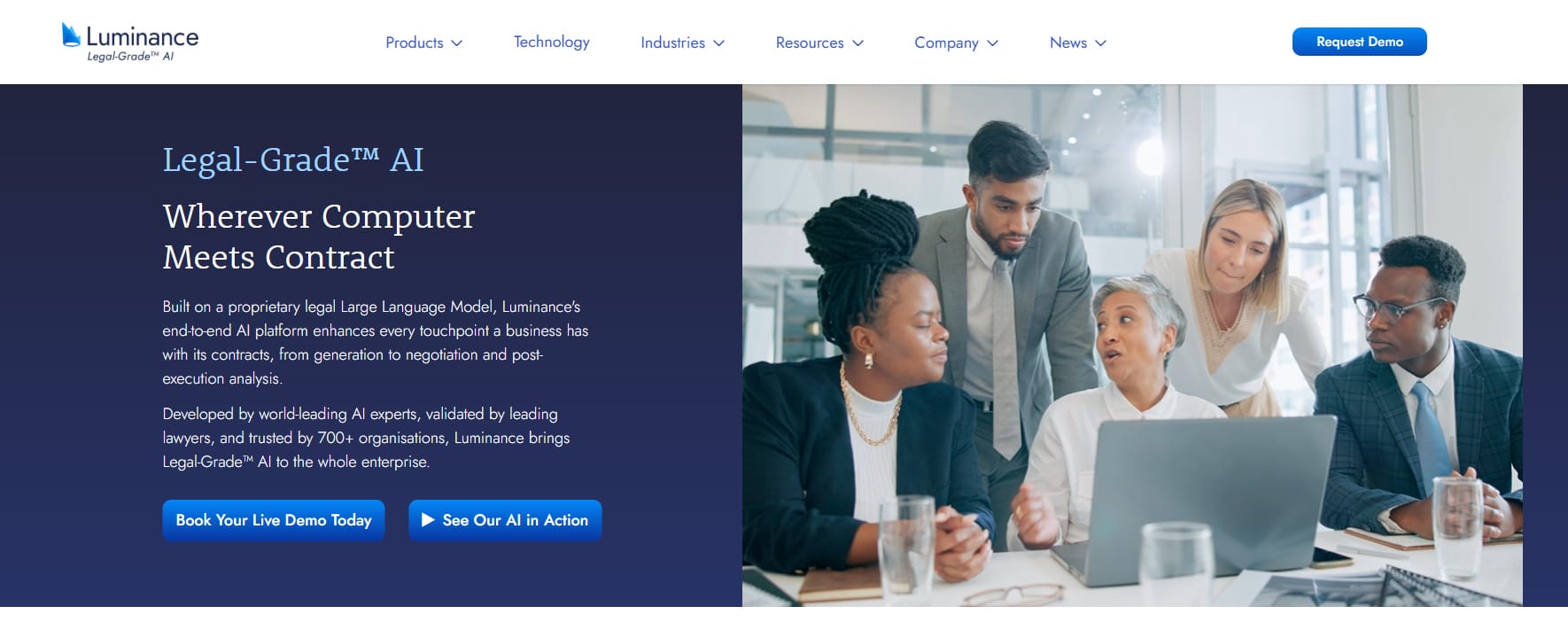
Source: Luminance.com
It is particularly effective in due diligence and contract analysis and can identify anomalies and patterns that might indicate risk or require further investigation.
Luminance’s AI understands language and document structure in a way that mimics human cognitive processes but with the ability to process information on a much larger scale.
Maximize Your Bottom Line With an Automated Discovery Process
Automating legal discovery starts a domino effect in your law firm. First, you upgrade your efficiency, which leads to better productivity and time management.
In turn, you’ll have more positive case outcomes and get more referrals from satisfied clients. At the end of the chain is a more competitive law firm and a superior bottom line.
With automation, your team can focus on high-value legal work instead of getting bogged down in tedious document reviews. So, are you ready to make the shift?
Get rid of the burden of creating discovery documents by hand. If you want to start optimizing your discovery process with state-of-the-art AI, book your free demo today!
Slash Hours From the Discovery Phase With Briefpoint
Discovery responses cost firms $23,240, per year, per attorney. $23,240 estimate assumes an associate attorney salary of $150,000 (including benefits – or $83 an hour), 20 cases per year/per associate, 4 discovery sets per case, 30 questions per set, 3.5 hours spent responding to each set, and 1800 hours of billable hours per year.
Book a demo and save on these costs with Briefpoint.
FAQs About the AI Legal Discovery Process
Is AI going to replace lawyers?
No, AI or e-discovery is intended to augment the capabilities of lawyers, not replace them. It handles the tedious aspects of legal work, allowing lawyers to focus on complex decision-making and continuous active learning.
How does AI ensure the confidentiality of sensitive information?
AI systems designed for legal work are built with stringent security measures and comply with privacy laws to protect sensitive information. Still, it’s important to read the terms and conditions to ensure the tools you are using are safe and secure.
Can small law firms afford AI-based discovery tools?
Yes, many AI tools are scalable and available as services, making them accessible to firms of all sizes. You can start with the basic packages, but you may need to expand to premium features or new tools as your law firm expands.
The information provided on this website does not, and is not intended to, constitute legal advice; instead, all information, content, and materials available on this site are for general informational purposes only. Information on this website may not constitute the most up-to-date legal or other information.
This website contains links to other third-party websites. Such links are only for the convenience of the reader, user or browser. Readers of this website should contact their attorney to obtain advice with respect to any particular legal matter. No reader, user, or browser of this site should act or refrain from acting on the basis of information on this site without first seeking legal advice from counsel in the relevant jurisdiction. Only your individual attorney can provide assurances that the information contained herein – and your interpretation of it – is applicable or appropriate to your particular situation. Use of, and access to, this website or any of the links or resources contained within the site do not create an attorney-client relationship between the reader, user, or browser and website authors, contributors, contributing law firms, or committee members and their respective employers.
How Can Law Firms Use AI in Litigation?
How Can Law Firms Use AI in Litigation?
Legal work takes time—lots of it. Attorneys spend hours on research, discovery, and drafting documents, and the workload never really slows down. But AI is changing the game to make litigation faster and a lot less tedious.
From automating routine tasks to pulling up relevant case law in seconds, AI is helping law firms work smarter. It’s improving accuracy, cutting costs, and freeing up time for the legal work that actually matters—strategy, client advocacy, and winning cases.
So, how does AI fit into litigation? What are the real benefits and the potential drawbacks? And what does this mean for the future of the legal profession?
This guide covers everything you need to know—from how law firms are using AI to how tools like Briefpoint are saving attorneys hours on discovery responses. Whether you’re already experimenting with AI or just curious about what’s next, this breakdown will give you a clear picture of AI’s role in modern litigation.

The Applications of AI in Litigation
Legal work is getting a boost from AI. Litigation is faster, more streamlined, and a lot less tedious, thanks to AI. Lawyers can now focus on the important parts of their job. Here’s how it’s being used in litigation today.
1. eDiscovery
Discovery is one of the most time-consuming parts of litigation. Finding the right stuff in a sea of emails, contracts, and case files takes forever. Lawyers and their assistants can spend weeks on this alone.
AI-powered eDiscovery tools take the heavy lifting off legal teams by scanning massive amounts of data in minutes.
Think of it like this: people reviewing things manually miss things. These tools, using machine learning, are much better at finding patterns, spotting errors, and highlighting important details. They’re much more accurate.
Instead of digging through endless documents, attorneys get a prioritized list of the most relevant files, making it easier to focus on building their case.
Besides saving you time, AI helps prevent those annoying little mistakes we all make sometimes. Overlooking evidence weakens any argument. But AI catches everything to minimize that problem.
With tighter deadlines and increasing data volumes in litigation, AI-driven eDiscovery helps firms stay ahead without getting buried in paperwork.
2. Legal Research
Finding the right case law, statutes, and legal precedents takes up a significant portion of an attorney’s time. Research platforms using AI speed things up; they quickly find the right cases and give you the main legal points.
Instead of manually combing through databases, lawyers can rely on AI to surface the most applicable rulings in seconds.
A few platforms offer case comparisons to show where arguments might fall short. Attorneys use this to make their strategies sharper.
Less time researching means more time crafting winning arguments for your clients.
3. Drafting Legal Documents
Legal document drafting is another area where AI is making a difference. Whether it’s responding to discovery requests, preparing contracts, or reviewing your legal writing, AI-powered tools automate much of the process with generative AI and large language models.
Generative AI tools generate templates based on past cases and legal best practices. Imagine trying to build a house without a blueprint. These tools are like that blueprint, making sure everything is done correctly and nothing is forgotten.
Essentially, using AI for writing is great for saving time; it handles a lot of the grunt work, but human review is still necessary.
A great example of this is Briefpoint, an AI-driven platform designed to handle discovery responses efficiently. Instead of spending hours drafting responses manually, attorneys can use Briefpoint to generate high-quality, customized discovery documents in minutes.
The tool automates formatting, inserts relevant objections, and structures responses based on legal standards—saving firms time and reducing errors.
By integrating AI-powered tools like Briefpoint, attorneys can focus more on case strategy and client advocacy rather than getting bogged down by repetitive paperwork.
4. Case Strategy and Predictions
One of AI’s most powerful applications in litigation is predictive analytics.
Using past cases and their results, AI can figure out the probable outcome of a new case. It does this by also looking at settlement patterns. Better decisions about settling versus trial are easier for attorneys with this information.
Some AI tools even assess the strengths and weaknesses of different legal arguments so lawyers can fine-tune their approach. While AI can’t guarantee an outcome, it provides valuable insights that help firms manage risk and develop stronger case strategies.

5. Compliance and Risk Management
AI is also playing a key role in regulatory compliance. Law firms dealing with highly regulated industries—such as finance, healthcare, and corporate law—use AI to review contracts and agreements for compliance risks.
Legal issues? These tools will flag them. Need contract revisions? They’ll suggest them. Want to compare your new contract to past agreements? These tools make it easy to achieve better consistency.
Firms can sidestep costly legal battles by automating compliance checks; this helps prevent missing important requirements.
6. Contract Review and Analysis
Reviewing contracts manually can take hours, especially for firms handling large volumes of agreements.
Contracts get a speed boost from AI; it spots inconsistencies, missing pieces, and possible problems. It can also compare agreements against previous versions to highlight any changes that may impact legal standing.
AI-powered contract analysis tools don’t just speed up reviews—they improve accuracy by catching details that a human reviewer might overlook.
This is particularly useful for transactional law, mergers and acquisitions, and employment agreements, where small errors can lead to significant legal consequences.
7. Client Communication and Chatbots
While AI won’t replace direct client interactions, it can make communication more efficient. Some law firms use AI-powered chatbots to handle routine inquiries, schedule consultations, and provide basic legal information. Lawyers gain extra time; clients get quicker responses.
Chatbots can’t offer legal advice, but they can assist with initial intake, document collection, and FAQs. Clients can access law firms more easily, and it doesn’t mean more work for the firms.
8. Fraud Detection and Investigations
Finding fraud and misconduct is easier with AI, mainly because it’s really good at picking up patterns in huge data sets.
Law firms and corporate legal departments use AI to analyze financial records, contracts, and communications for suspicious activity. Spotting possible fraud is easier for legal teams thanks to these tools, which identify irregularities. Investigations become more efficient as a result.
AI is particularly useful in white-collar crime cases, regulatory investigations, and corporate compliance audits, where finding key evidence quickly can make a significant difference.
What Are The Benefits of Adopting AI Into Your Practice?
AI isn’t just about speeding up processes—it brings real, measurable advantages to law firms. By handling repetitive legal tasks, improving accuracy, and reducing costs, AI allows attorneys to focus on strategy, client relationships, and complex work.
Here’s how integrating AI into your practice can make a difference.
Faster, More Efficient Workflows
Legal work comes with a ton of paperwork, research, and repetitive tasks, especially during litigation. AI takes a lot of that off an attorney’s plate by speeding up processes like document review and case research.
For example, generative AI models and natural language processing (NLP) can help you draft documents in minutes instead of the hours (or days) it would usually take.
So, instead of spending eternity digging through discovery documents or searching for relevant case law, AI can pull up what’s needed in minutes. That means lawyers can focus more on case strategy and less on tedious admin work.
Cost Savings
Law firms run on billable hours, but not all billable work adds real value.
Automating routine tasks like legal research and document creation with AI offers substantial cost reductions. This efficiency boost translates directly to the bottom line for businesses. For example, a law firm could reduce its administrative costs by 15% or more.
Take Briefpoint, for example—it slashes the time attorneys spend drafting discovery responses, saving firms around $20,477 per year, per attorney. That’s money that can be reinvested into client service, firm growth, or even taking on more cases without overloading the team.
Improved Accuracy and Reduced Errors
Even the best attorneys can miss small details when reviewing stacks of documents. AI provides an extra layer of accuracy by flagging inconsistencies, spotting missing clauses in contracts, and identifying compliance risks before they become problems.
It won’t replace human judgment, but it can help make sure nothing slips through the cracks. With AI handling the heavy lifting, legal teams can be more confident that their research and filings are rock-solid.
Better Decision-Making
By analyzing past rulings, settlement trends, and even judge behavior, AI can predict case outcomes with surprising accuracy. Before court or settlement talks, this gives lawyers a much better idea of their likelihood of success.
High-stakes litigation? Forget relying solely on intuition. Data-driven strategies provide a powerful competitive edge.
More Time for High-Value Work
Legal work isn’t just about filing motions and drafting contracts—client relationships and courtroom strategy matter just as much. AI helps attorneys shift their focus from repetitive admin tasks to the work that truly moves the needle.
Because AI now does the legwork of research, document preparation, and compliance reviews, lawyers have more time for the things that really matter: building winning cases, negotiating fair settlements, and providing expert advice to their clients.
This means better representation for everyone.
Better Client Service
Clients want quick answers and timely updates, and AI helps law firms deliver just that. Chatbots and virtual assistants can handle basic client inquiries, schedule meetings, and even help with initial case intake.
AI-powered document automation tools also speed up response times, so clients aren’t left waiting on paperwork. Ultimately, this results in a more seamless experience for clients and less back-and-forth for attorneys.
Scalability for Law Firms
Growing a law firm takes more than just adding new attorneys—it requires efficient processes. AI makes it easier for firms to scale without hiring an army of associates.
Smaller businesses can handle a bigger caseload by automating their busywork. This prevents them from becoming overloaded.
It’s a win-win: Smaller legal practices can compete with larger ones by providing excellent service at a reasonable cost. This means clients get quality representation without the hefty price tag.
Are There Any Limitations or Drawbacks to AI-Powered Litigation?
AI is a powerful tool, but it’s not perfect.
One of the biggest concerns is that AI lacks human judgment. While it can analyze documents, predict case outcomes, and automate research, it doesn’t understand legal nuances the way a trained attorney does. Complex cases require strategic thinking, negotiation skills, and ethical considerations that AI simply can’t handle.
Bias is another issue. AI learns from the past. So, if past court cases showed bias, the AI might repeat those same mistakes. Attorneys must check AI suggestions; otherwise, predictions and recommendations might be biased.
There’s also the matter of cost and implementation. While AI can save money in the long run, high-quality legal AI tools require upfront investment and ongoing training. Firms must integrate these tools into their workflow and make sure staff knows how to use them effectively.
Don’t forget the laws and the moral side of things. These are critical considerations. Legal work from AI needs a lawyer’s check to make sure it’s right and follows all the rules.
Courts may also challenge AI-generated filings or arguments, making it clear that while AI can assist in litigation, it won’t be replacing attorneys anytime soon.
What Does AI Mean For the Future of the Legal Profession?
The legal field is changing thanks to AI, and it’s happening faster than most people thought. When OpenAI first released ChatGPT, most law firms weren’t paying much attention.
A survey from Thomson Reuters found that only 3% of attorneys and law firm staff were actually using AI, and 60% had no plans to adopt it. Even firms that were considering AI were hesitant to implement it in real legal work.
Less than a year later, the landscape had completely shifted. A follow-up survey of top U.S. law firms revealed that AI was already making an impact.
While many firms initially limited its use to internal tasks that didn’t involve client data, nearly half of the Am Law 100 firms had started actively using AI for legal research, business operations, and case strategy.
This rapid adoption shows that AI isn’t just a passing trend for the legal industry—it’s a fundamental shift in how legal work gets done. While AI won’t replace attorneys, firms that embrace it will be better positioned to stay competitive, improve efficiency, and provide faster, more accurate legal services.
Your Discovery Process Doesn’t Have to Be a Drag
Here’s a clear fact—litigation comes with a lot of tedious work. You didn’t become a lawyer to spend hours drafting discovery responses or digging through endless case files. And this is exactly why AI is becoming more and more of a necessity for legal professionals these days.

Adopting AI is all about giving you the tools to work faster and more efficiently. The firms that embrace AI aren’t drowning in paperwork. They’re focusing on case strategy, client advocacy, and winning.
If you’re tired of spending hours on discovery drafting, Briefpoint makes it simple. Generate structured, professional responses in minutes instead of wasting valuable time on formatting and repetitive edits. More efficiency means more time for legal work that actually matters!
See what it can do for your legal practice—schedule a Briefpoint demo today.
Make Your Litigation Workflows More Value-Adding
Discovery responses cost firms $23,240, per year, per attorney. $23,240 estimate assumes an associate attorney salary of $150,000 (including benefits – or $83 an hour), 20 cases per year/per associate, 4 discovery sets per case, 30 questions per set, 3.5 hours spent responding to each set, and 1800 hours of billable hours per year.
Book a demo and save on these costs with Briefpoint.
FAQs About AI in Litigation
How is artificial intelligence used in litigation?
AI helps law firms with tasks like eDiscovery, legal research, document drafting, and case analysis. It speeds up data-heavy processes, reducing the time attorneys spend sorting through documents and finding relevant case law. Some firms also use AI-powered predictive analytics to assess case outcomes and optimize their legal operations.
How can AI be used in the legal profession?
AI is transforming the legal profession by automating routine tasks, improving research accuracy, and streamlining contract analysis. Law firms (and even law schools) use AI for document review, compliance checks, fraud detection, and even client communication through AI-powered chatbots.
How is AI being used in court?
While AI doesn’t argue cases, it assists attorneys and judges by organizing case materials, analyzing past rulings, and identifying key precedents. Some courts use AI-powered tools for legal research, while others explore AI-driven case management systems to improve efficiency. However, AI-generated arguments and filings still require human oversight to meet legal and ethical standards.
What are the AI lawsuits in 2024?
Several lawsuits in 2024 involve AI, focusing on issues like copyright infringement, data security, and liability for AI-generated content. Some cases challenge how AI models use copyrighted materials for training, while others address concerns over AI bias and its impact on legal decisions. Courts are also reviewing regulations on AI use in various industries, with a particular focus on compliance with laws like the California Consumer Privacy Act (CCPA). As AI continues to evolve, legal battles are shaping future standards for data protection, intellectual property, and responsible AI deployment.
The information provided on this website does not, and is not intended to, constitute legal advice; instead, all information, content, and materials available on this site are for general informational purposes only. Information on this website may not constitute the most up-to-date legal or other information.
This website contains links to other third-party websites. Such links are only for the convenience of the reader, user or browser. Readers of this website should contact their attorney to obtain advice with respect to any particular legal matter. No reader, user, or browser of this site should act or refrain from acting on the basis of information on this site without first seeking legal advice from counsel in the relevant jurisdiction. Only your individual attorney can provide assurances that the information contained herein – and your interpretation of it – is applicable or appropriate to your particular situation. Use of, and access to, this website or any of the links or resources contained within the site do not create an attorney-client relationship between the reader, user, or browser and website authors, contributors, contributing law firms, or committee members and their respective employers.
Discovery Objections Cheat Sheets: Full Guide
Discovery Objections Cheat Sheets: Full Guide
Handling discovery requests is a necessary but time-consuming part of litigation. Whether you’re responding to interrogatories, requests for admission (RFAs), or requests for production (RFPs), objections can help you protect your client and limit unnecessary disclosures.
Want a quick reference guide to common discovery objections? Use the Discovery Objections Cheat Sheet today.
Discovery Objections Overview
Discovery objections let you challenge or limit a request from the opposing party. They help:
- Protect privileged information
- Prevent fishing expeditions (overly broad or burdensome requests)
- Ensure relevance to the case
- Avoid unnecessary delays and costs
Each jurisdiction has its own rules, but objections must always be specific and justified. Courts don’t like blanket objections that lack detail or seem like stalling tactics.

What Are Common Objections to Discovery Requests?
Here’s a breakdown of common discovery objections and when they apply:
1. Relevance
A relevance objection is used when a discovery request seeks information that has no connection to the claims or defenses in the case.
Courts generally allow broad discovery, but requests must still be reasonably related to the legal issues at hand. If a request asks for irrelevant, outdated, or unrelated information, you can object on these grounds.
However, it’s important to explain why the request is irrelevant rather than just stating the objection.
Example: “Objection. The requested documents concern events that occurred outside the relevant time frame and have no bearing on the issues in dispute.”
Remember: A strong relevance objection should specify why the request is irrelevant while still complying with discovery obligations where necessary.
2. Overbroad and Unduly Burdensome
An objection for being overbroad and unduly burdensome comes into play when a discovery request isn’t clear, asks for too much, or takes way too much time and effort to respond to.
Courts allow broad discovery, but they also expect requests to be reasonable. If a request doesn’t set clear limits on time, subject matter, or scope, it can turn into a massive task that eats up unnecessary resources. But just saying a request is “too broad” isn’t enough—courts want to see why it’s a problem.
Example: “Objection. This request is overbroad and unduly burdensome as it seeks ‘all documents’ related to the matter, without any reasonable limits on time or subject.”
If only part of the request is overbroad, you should respond to the reasonable portion while objecting to the rest. Courts prefer narrowing requests rather than outright refusal, so offering to meet and confer can help avoid disputes.
3. Privileged Information
An objection for privileged information is used when a discovery request asks for materials protected by attorney-client privilege, work product doctrine, or other legal protections.
Courts take privilege seriously, but objections need to be specific—you can’t just claim privilege without explaining why the information is protected. If you withhold documents, you’ll likely need to provide a privilege log listing what’s being withheld and why.
Example: “Objection. This request seeks information protected by the attorney-client privilege and is therefore not subject to disclosure.”
If only part of the response is privileged, courts expect you to produce the non-privileged portions while redacting the protected content.
Keeping a detailed privilege log can help avoid challenges and show that you’re withholding information for a valid reason, not just to block discovery.
4. Vague or Ambiguous
An objection for being vague or ambiguous applies when a discovery request is unclear, confusing, or open to multiple interpretations. If the wording is too broad or poorly defined, it can be difficult to know exactly what’s being asked.
Courts expect objections to be reasonable, so if a request can be clarified, it’s often better to ask for clarification rather than refuse to respond altogether.
Example: “Objection. This request is vague and ambiguous as it fails to define the term ‘relevant communications,’ making it unclear what is being sought.”
5. Confidential or Private Information
An objection for confidential or private information is appropriate when a discovery request asks for sensitive business data, personal records, or legally protected material. While courts recognize the need for broad discovery, they also expect parties to protect trade secrets, financial details, medical records, and other confidential data.
Simply labeling something as “confidential” won’t be enough—if the information is relevant, a court may allow disclosure under a protective order to limit who can access it and how it’s used.
Examples: “Objection. The request seeks confidential business records containing proprietary information not subject to unrestricted disclosure.”
Instead of outright refusing, consider discussing possible limitations or safeguards with the opposing party to avoid unnecessary court intervention.

6. Already Available
Courts generally don’t require a party to produce materials that the other side can easily obtain on their own, especially if they’re public records, already in possession of the requesting party, or available from a third-party source.
An objection for already available information applies when the requesting party has equal access to the documents or data they’re asking for.
Examples: Objection. The requested documents are equally available to the requesting party through publicly accessible records.”
If the request involves public or easily accessible records, you can reference where the party can obtain them rather than producing the documents yourself.
7. Calls for a Legal Conclusion
A discovery request asks, “Do you admit that the defendant was negligent in causing the accident?” This type of question isn’t just seeking facts—it’s asking for a legal analysis that only a judge or jury can decide.
Discovery is meant to gather factual information, not force a party to make legal conclusions. When a request crosses that line, it’s appropriate to object.
Examples: “Objection. This request calls for a legal conclusion and is therefore improper under the rules of discovery.”
8. Compound Request
An objection for compound requests or compound questions is appropriate when a discovery request combines multiple inquiries into one, which makes it difficult to determine exactly what’s being asked.
Requests should be clear and specific, but when a single request covers multiple topics, timeframes, or document categories, it can create confusion or require separate responses.
Examples: “Objection. This request is compound, as it includes multiple separate inquiries that should be broken down into distinct requests.”
When a request includes both clear and unreasonable parts, responding to what makes sense while objecting to the rest is usually the best approach.
9. Calls for Speculation
Speculative questions in discovery are improper because they require a party to guess rather than provide factual information. Requests that ask how someone might have acted under different circumstances or what another person was thinking go beyond what discovery allows.
Courts expect responses to be based on personal knowledge or available admissible evidence, not assumptions.
Example: “Objection. The question asks the responding party to predict actions or thoughts of another individual, which is not proper for discovery.”
If part of the request can be answered with known facts, it’s best to respond to that portion while objecting to the speculative parts. Courts typically reject blanket refusals if any part of the request is reasonable.
10. Calls for an Expert Opinion
Requests that demand technical analysis, medical evaluations, or legal interpretations often fall outside the scope of standard discovery responses. If a question requires specialized knowledge that only a qualified expert can provide, it’s appropriate to object.
Example: “Objection. This request calls for an expert opinion, which the responding party is not qualified to provide.”
If the responding party has relevant expertise, the court may still require an answer. However, if the request truly requires expert input, the appropriate response is to object and refer the matter to expert witnesses designated in the case.
Try Briefpoint for Faster, More Accurate Discovery Responses
Discovery responses can take hours of tedious work, but they don’t have to. Briefpoint automates the process, helping attorneys draft objections and responses in seconds while staying compliant with discovery rules.

Instead of manually reviewing and formatting every response, you can rely on AI-driven automation to handle the heavy lifting—saving time without sacrificing accuracy.
If you’re ready to speed up your discovery workflow, try Briefpoint today and see how automation can simplify your responses. Schedule a demo to see it in action.
Speed Up Your Discovery Process While Saving Money
Discovery responses cost firms $23,240, per year, per attorney. $23,240 estimate assumes an associate attorney salary of $150,000 (including benefits – or $83 an hour), 20 cases per year/per associate, 4 discovery sets per case, 30 questions per set, 3.5 hours spent responding to each set, and 1800 hours of billable hours per year.
Book a demo and save on these costs with Briefpoint.
FAQs About Discovery Objections Cheat Sheet
Can I object to a discovery request just because I don’t want to respond?
No. Objections must be valid under the federal rules of civil procedure and cannot be used just to avoid answering. If a request seeks relevant evidence, a refusal without a proper legal basis may lead to a motion to compel. Courts also dislike boilerplate objections that don’t explain why the request is improper.
What should I do if the opposing counsel challenges my objection?
If opposing counsel disputes an objection, it’s best to try to resolve the issue informally before escalating. Many courts require parties to meet and confer to discuss objections before filing a motion to compel. Providing a clear explanation of the objection and suggesting alternatives can help prevent unnecessary court intervention.
Can an objection weaken my party’s claim?
Not necessarily, but improper objections can create issues. If an objection is unjustified or overused, the court may order compliance, which could impact the party’s claim by forcing the disclosure of damaging information. Using objections strategically and within the rules ensures that only proper, discoverable material is produced.
The information provided on this website does not, and is not intended to, constitute legal advice; instead, all information, content, and materials available on this site are for general informational purposes only. Information on this website may not constitute the most up-to-date legal or other information.
This website contains links to other third-party websites. Such links are only for the convenience of the reader, user or browser. Readers of this website should contact their attorney to obtain advice with respect to any particular legal matter. No reader, user, or browser of this site should act or refrain from acting on the basis of information on this site without first seeking legal advice from counsel in the relevant jurisdiction. Only your individual attorney can provide assurances that the information contained herein – and your interpretation of it – is applicable or appropriate to your particular situation. Use of, and access to, this website or any of the links or resources contained within the site do not create an attorney-client relationship between the reader, user, or browser and website authors, contributors, contributing law firms, or committee members and their respective employers.
Best AI for Legal Documents: Top 7 Tools in 2025
Best AI for Legal Documents: Top 7 Tools in 2025
The best AI for legal documents makes legal work easier, yet plenty of law firms are still hesitant to jump on board. Some worry about accuracy, while others don’t want to change the way they’ve always done things. But the reality is AI isn’t replacing lawyers—it’s taking tedious work off their plates.
From drafting discovery responses to reviewing contracts and conducting legal research, AI-powered legal tools help firms work smarter, not harder.
Whether you’re running a solo practice, part of a big firm, or handling documents in an in-house legal department, the right AI can save time, reduce errors, and let you focus on more important legal work.
This guide breaks down the best AI tools for legal documents so you can find the right tool to fit your workflow.

Types of AI Tools for Legal Documents
First things first, let’s talk about the different types of AI tools for legal documents. Not all legal AI tools do the same thing—some focus on drafting, while others handle research or contract management. Here are the main types of AI tools per the process they cover:
- Contract drafting: These tools help create legal documents using templates and user inputs, saving lawyers hours of manual work.
- Legal document drafting: Creates pleadings, discovery documents, contracts, and other legal paperwork based on templates and case details. It expedites the drafting process while maintaining accuracy.
- Document review: Speeds up contract analysis by identifying risks, missing clauses, and inconsistencies.
- Legal research: Finds relevant case law, statutes, and regulations quickly, cutting down the time spent on legal research.
- E-signature and contract management: Simplifies contract signing, tracking, and storage, ensuring deadlines aren’t missed.
- Litigation support: Assists with case analysis, summarizing legal documents, and predicting case outcomes.
Each of these tools plays a role in making legal work faster, more efficient, and less prone to errors. The right tool depends on what you need—whether it’s drafting, reviewing, or managing legal documents.
Top AI Tools for Legal Documents
The right tool can cut down on repetitive tasks, reduce errors, and improve efficiency. But which one will meet your exact needs?
Below are some of the best AI tools for legal documents, each offering unique features to help your legal practice run more smoothly.
1. Briefpoint
Briefpoint is an AI-powered tool designed to automate the drafting of discovery documents and other legal filings. Instead of spending hours manually preparing responses, legal professionals can generate well-structured documents in minutes.

By extracting key details from case files and applying standardized legal formatting, Briefpoint reduces errors and makes document drafting faster and way more efficient.
How It Works
- Upload your discovery request: Just drag and drop your opposing counsel’s discovery requests into Briefpoint. The AI instantly scans the document and extracts key details, including court names, case numbers, parties, request types (RFA, RFP, or interrogatory), and set numbers. No more wasting time inputting basic case info.
- Add objections and responses: Briefpoint doesn’t just copy and paste—it structures your responses while giving you full control over objections. You can select from common objections so responses are accurate and properly formatted without repetitive manual work.
- Collect responses from your clients: Briefpoint Bridge helps you translate interrogatories into simple English, send them to your clients, and then integrate their responses directly into your document.
- Open in Word & finalize: Once your responses are generated, you can download them as a Word document. The file is already formatted and mostly completed—just make any final edits before filing.
Pros
- Drafts documents in minutes instead of hours
- Makes sure responses are consistent and properly formatted
- Works with case management systems through Briefpoint Bridge
- Automatically fills in standard objections and responses
- Designed for quick adoption without a steep learning curve
If you want a full tour of Briefpoint, book your free demo today!
2. CoCounsel by Casetext
CoCounsel is an AI-powered legal assistant that helps lawyers with research, contract review, and document analysis. Developed by Casetext, it automates time-consuming legal tasks, which allows attorneys to focus on case strategy.
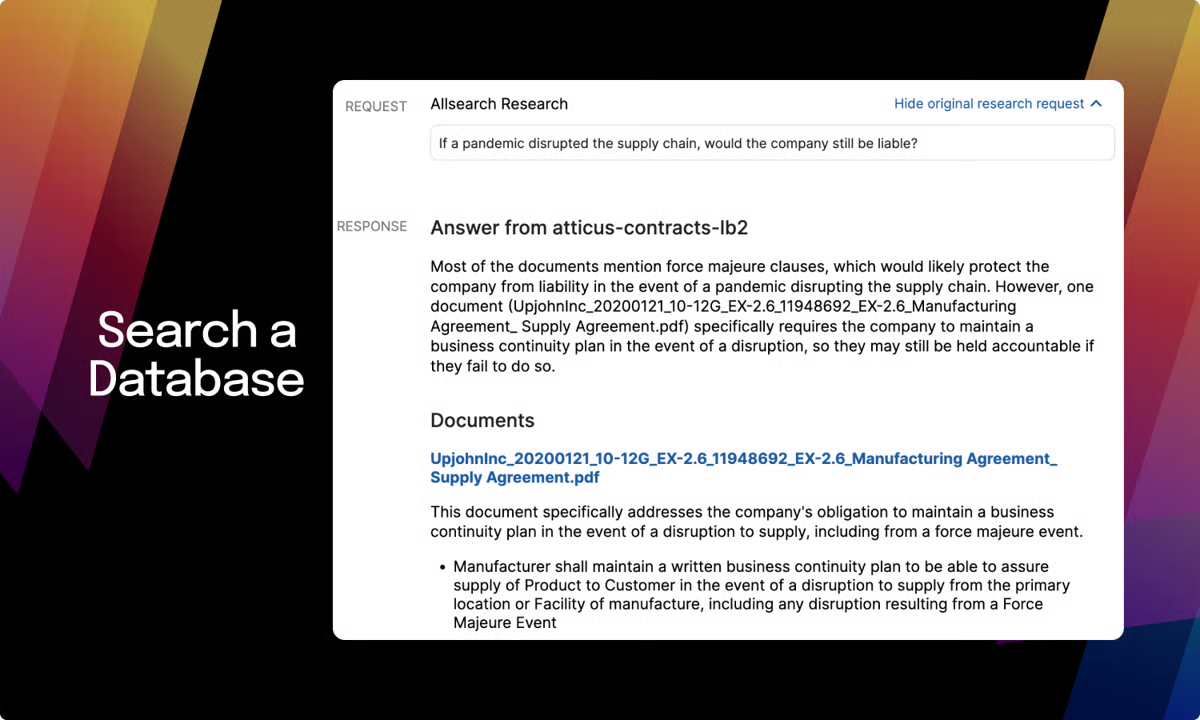
Source: G2
With features like document summarization, deposition preparation, and contract analysis, it acts as a virtual legal associate that can help improve efficiency in daily workflows.
Key Features
- Legal research assistance: Quickly finds relevant case law, statutes, and regulations.
- Contract review: Analyzes contracts, flags potential risks, and ensures compliance.
- Deposition preparation: Helps attorneys organize key points and review testimony.
- Legal document summarization: Extracts critical details from lengthy documents.
- Case analysis: Identifies key arguments, supporting evidence, and relevant precedents.
Pros
- Finds case law and statutes faster than manual searches
- Flags risks and missing clauses with AI-powered insights
- Automates repetitive tasks, reducing workload for legal teams
- Designed for easy adoption without a steep learning curve
Cons
- Pricing may be too high for smaller firms, which starts at $247 per month
- AI-generated insights still need attorney review
- Some features may not align with all legal systems
3. ChatGPT
ChatGPT isn’t designed specifically for law firms, but it can handle a variety of legal-adjacent tasks. From drafting emails and summarizing case law to generating legal arguments and reviewing documents, it serves as a versatile AI assistant.

Source: G2
While it doesn’t replace specialized legal AI, many lawyers use it to speed up routine work, brainstorm ideas, and refine legal writing.
Key Features
- Legal writing assistance: Helps draft contracts, emails, and legal memos with clear and structured language.
- Document summarization: Condenses case law, statutes, and legal documents into digestible summaries.
- Legal research support: Helps locate case law, statutes, and legal concepts (though accuracy requires verification).
- Contract review assistance: Identifies potential issues in contracts and suggests revisions.
- General productivity support: Assists with scheduling, transcription, and other administrative tasks.
Pros
- Can assist with legal research, writing, and administrative tasks
- Quickly generates drafts, summaries, and contract reviews
- More budget-friendly than specialized legal AI tools
- No complex setup or integrations required
Cons
- Doesn’t replace dedicated legal AI tools
- Responses need attorney oversight to ensure accuracy
- Can highlight risks but lacks deep legal expertise.
4. ContractSafe
Keeping track of contracts can be a headache, especially when deadlines sneak up or important terms get buried in piles of paperwork.
Source: G2
ContractSafe makes it easier to store, search, and manage contracts without the usual hassle. With AI-powered search, automated reminders, and secure storage, it helps legal teams and businesses stay organized and avoid costly mistakes.
It’s not a full-fledged contract analysis tool, but for teams looking for a simple way to track and manage agreements, ContractSafe takes the stress out of contract organization.
Key Features
- AI-powered search: Instantly locates contract terms, clauses, and key details with a simple keyword search.
- Automated deadline reminders: Sends alerts before contract renewals, expirations, or important obligations.
- Secure document storage: Keeps all contracts in a centralized, searchable database.
- User permissions & access control: Lets teams control who can view, edit, or download contracts.
- Integrations with business tools: Works with CRM and document management systems for a smoother workflow.
Pros
- Makes finding contracts quick and easy
- Prevents missed deadlines with automated reminders
- No complex setup or IT support needed
- Supports team collaboration with access controls
Cons
- Doesn’t provide deep contract risk analysis
- Lacks AI-powered contract review features
- Focuses on organization rather than drafting or legal insights
5. DocuSign
DocuSign makes signing and managing legal documents faster, more secure, and completely digital. With legally binding e-signatures and automated workflows, it helps businesses and law firms handle agreements without the back and forth of printing, scanning, and mailing.

Source: G2
While it’s best known for e-signatures, DocuSign also offers contract management tools that help teams speed up approvals, track agreements, and stay compliant with legal standards.
Key Features
- Legally binding e-signatures: Allows users to sign contracts securely from anywhere.
- Automated contract workflows: Simplifies the process of sending, signing, and finalizing agreements.
- Audit trails & compliance tracking: Keeps a secure record of document activity for legal protection.
- Secure cloud storage: Stores signed contracts in a centralized system with encryption.
- Integrations with business & legal software: Works with CRM, document management, and legal tech platforms.
Pros
- Speeds up contract signing with secure e-signatures
- Reduces paperwork and manual contract management
- Provides audit trails for legal compliance
- Works across multiple devices for remote access
Cons
- Doesn’t analyze contracts for risks or legal issues
- Can be expensive for smaller businesses or solo practitioners
- Some advanced features require higher-tier plans
6. MyCase
Keeping legal documents organized can be a challenge in the legal profession, especially when juggling multiple cases. MyCase makes document storage simple by providing a secure, cloud-based system designed for law firms.
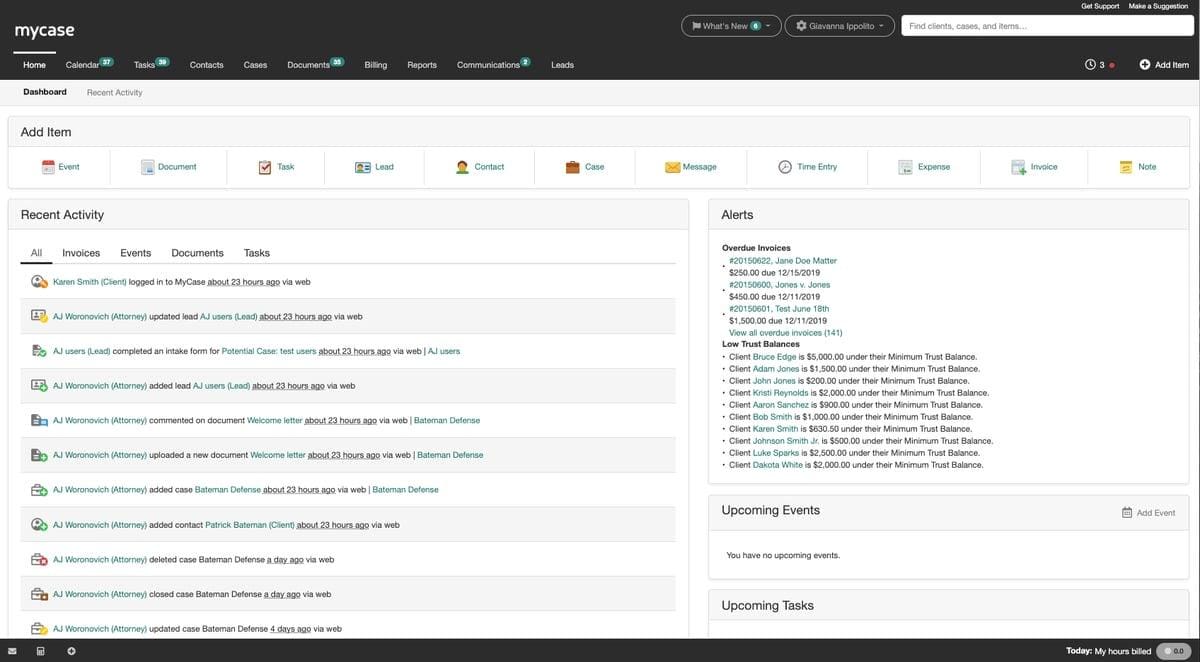
Source: G2
It helps attorneys store, access, and manage case files in one place, which helps reduce the risk of lost or misplaced documents.
MyCase offers other legal management tools, but its document storage feature makes sure all case-related files are easy to find, securely stored, and accessible from anywhere.
Key Features
- Cloud-based document storage: Keeps legal files organized and accessible from any device.
- Advanced search & tagging: Makes it easy to find case documents with filters and keyword searches.
- Role-based access control: Allows firms to manage who can view, edit, or download documents.
- Client portal integration: Lets clients securely access shared legal documents.
- Automatic backups & security encryption: Protects files from accidental loss or unauthorized access.
Pros
- Keeps all legal documents in one secure location
- Makes it easy to search and retrieve case files
- Allows controlled access for clients and team members
- Provides cloud-based access for remote work
Cons
- Doesn’t include AI-powered contract review or analysis
- Some features require higher-tier pricing plans
- May not be as advanced as dedicated document management systems
7. Harvey AI
AI is making legal work faster and more efficient, and Harvey AI is one of the newest tools built specifically for law firms.

Source: Harvey.ai
Designed to assist with legal research, contract review, and document analysis, Harvey AI helps lawyers process large amounts of information quickly while maintaining accuracy.
No AI can be a total replacement for human legal expertise. Nevertheless, many firms use Harvey AI to speed up repetitive tasks, analyze legal documents, and improve decision-making.
Key Features
- AI-powered legal research: Finds relevant case law, statutes, and legal precedents in seconds.
- Contract analysis & review: Identifies key clauses, missing terms, and potential risks in agreements.
- Litigation support: Assists with drafting legal arguments and summarizing case details.
- Document summarization: Extracts important points from long legal documents to save time.
- Natural language processing: Understands complex legal language and provides insights based on queries.
Pros
- Speeds up legal research by quickly retrieving relevant cases
- Helps identify risks and missing clauses in contracts
- Reduces the time spent summarizing lengthy legal documents
- Uses advanced AI to interpret legal language accurately
Cons
- Requires human oversight to verify AI-generated insights
- May not fully replace traditional contract review methods
- Pricing may be too high for solo practitioners or small firms
What Are the Benefits of Legal AI Tools for Legal Documents?
Legal AI tools do more than speed up work—they improve accuracy, compliance, and overall efficiency. From drafting contracts to reviewing agreements and organizing case files, AI takes care of the tedious tasks.
Before we start talking about the best AI tools, let’s go over why you should have them in the first place.
Speeds Up Document Drafting
Drafting legal documents takes time, but AI makes it a whole lot faster. Instead of starting from scratch every time, lawyers can generate complete, well-structured documents in minutes.
AI tools pull in key details, suggest relevant clauses, and format everything properly, cutting down on repetitive work.
Take Briefpoint, for example—it automates legal drafting by pulling case details and structuring them into polished documents. That means less time spent on manual entry and more time focusing on the actual case.
With tools like this, lawyers don’t have to get stuck in paperwork—they can move through their workload faster and more efficiently.
Reduces Human Errors
Mistakes in legal documents can lead to serious consequences, but AI helps catch them before they become a problem.
It scans for inconsistencies, missing clauses, and formatting mistakes that might slip through in manual reviews. By flagging these issues early, AI lowers the risk of legal disputes caused by overlooked details.
Common errors AI can detect include:
- Inconsistent terminology
- Missing key clauses
- Formatting mistakes
- Duplicate or conflicting sections
- Incorrect dates or names
- Ambiguous language
- Non-compliant contract terms
With AI handling the tedious review work, lawyers can feel more confident that their documents are accurate and airtight.
Improves Compliance With Legal Standards
Legal documents need to follow strict guidelines, and AI helps make sure nothing falls through the cracks. Many AI tools are built with legal frameworks in mind, and they can review compliance with industry and regulatory requirements without constant manual review.
For example, some contract management tools automatically flag terms that don’t meet specific legal standards or suggest revisions based on recent regulations. This helps law firms and businesses stay compliant without having to comb through every document line by line.
Instead of worrying about missing an important requirement, legal teams can rely on AI to keep their documents in check.
Maximizes Contract Review Efficiency
Manually reviewing contracts takes time, but AI speeds up the process. AI-powered tools scan documents in seconds, flagging risks, obligations, and key clauses that need attention.
These tools highlight missing terms, inconsistent language, and potential compliance issues, making it easier to catch problems early. Some platforms even provide side-by-side comparisons to track changes between versions.
Saves Costs on Administrative Tasks
Nobody wants to waste time on paperwork, and AI helps cut down on it. By handling routine tasks like document drafting, contract management, and data entry, AI lets law firms spend less on admin work and more on what really matters.
For example, AI can auto-fill forms, generate contracts from templates, and organize case files without anyone having to do it manually. That means fewer billable hours lost to repetitive work and more time for legal teams to focus on clients.
Supports Legal Research and Case Preparation
Some AI tools can scan thousands of past cases, legal precedents, and regulations in seconds to pull out the most relevant information.
This helps lawyers build stronger arguments without spending hours flipping through legal texts. Some AI tools even summarize key points from cases, which helps make it easier to spot trends and key rulings.
With quick access to the right information, legal teams can prepare cases more efficiently and focus on strategy instead of getting lost in research.
Keeps Documents Organized and Accessible
Legal files pile up fast, and finding the right document can be a hassle. AI helps by sorting, categorizing, and tracking legal files so everything stays organized.
With AI-powered tools, contracts, case files, and agreements are easy to search and retrieve. Some platforms even tag documents based on keywords, client names, or contract terms, cutting down on time spent hunting for files. Automated reminders also help legal teams stay on top of deadlines.
Start Automating Your Biggest Bottleneck With Briefpoint
Plenty of AI tools can help optimize your law firm, but the real game-changer is eliminating the most tedious tasks. Discovery document drafting slows down legal teams, eats up billable hours, and leaves too much room for human error.
That’s where Briefpoint makes a difference.
By automating discovery responses, Briefpoint takes the manual work out of drafting Requests for Admission, Requests for Production, and Interrogatories.
Instead of spending hours formatting and writing, you can upload a discovery request, generate a structured response, and finalize it in minutes. It’s fast, accurate, and designed to fit into your existing workflow with Briefpoint Bridge.
If discovery responses are holding your firm back, it’s time to make a change, just like the 500+ law firms who already trust Briefpoint.
Schedule a demo today and see how Briefpoint can help you get through your workload faster—with fewer headaches!
Take Your Time and Money Back This Year
Discovery responses cost firms $23,240, per year, per attorney. $23,240 estimate assumes an associate attorney salary of $150,000 (including benefits – or $83 an hour), 20 cases per year/per associate, 4 discovery sets per case, 30 questions per set, 3.5 hours spent responding to each set, and 1800 hours of billable hours per year.
Book a demo and save on these costs with Briefpoint.
FAQs About Best AI for Legal Documents
Which AI is best for legal documents?
The best AI for legal documents depends on what you need. Briefpoint is great for discovery responses, while CoCounsel by Casetext assists with contract review and case analysis. DocuSign simplifies e-signatures and contract management, and Harvey AI helps in-house legal departments with research and document analysis. The right choice depends on your firm’s workflow and specific needs.
What is the best AI tool to write papers?
For drafting legal papers, ChatGPT and Harvey AI are strong options. These generative AI tools can help structure legal arguments, summarize cases, and refine legal writing. However, they still require attorney oversight to confirm accuracy.
Which GPT is best for law?
GPT-4 is currently the most advanced generative AI model for legal work. It can assist with contract drafting, case law summaries, and legal analysis. CoCounsel by Casetext and Harvey AI are built on GPT-4 and are fine-tuned for the legal industry, making them better suited for law firms than general-purpose AI.
Is there an AI for legal research?
Yes, several AI legal tools are designed to conduct legal research efficiently. CoCounsel by Casetext and Harvey AI can search for relevant case law, statutes, and precedents quickly. These tools help legal practice professionals find the right information without spending hours manually searching through databases.
The information provided on this website does not, and is not intended to, constitute legal advice; instead, all information, content, and materials available on this site are for general informational purposes only. Information on this website may not constitute the most up-to-date legal or other information.
This website contains links to other third-party websites. Such links are only for the convenience of the reader, user or browser. Readers of this website should contact their attorney to obtain advice with respect to any particular legal matter. No reader, user, or browser of this site should act or refrain from acting on the basis of information on this site without first seeking legal advice from counsel in the relevant jurisdiction. Only your individual attorney can provide assurances that the information contained herein – and your interpretation of it – is applicable or appropriate to your particular situation. Use of, and access to, this website or any of the links or resources contained within the site do not create an attorney-client relationship between the reader, user, or browser and website authors, contributors, contributing law firms, or committee members and their respective employers.
10 Best Legal Tech Companies of 2025
10 Best Legal Tech Companies of 2025
Legal tech is changing how law firms work, even as we speak. With the emergence of these modern solutions, integrating more intuitive tools into your law firm has become necessary.
However, budgets are limited, and there are many legal tech tools from which to choose.
In this article, we’ve compiled a list of the 10 best legal tech companies worth investing in.
1. Briefpoint.ai
Briefpoint.ai takes away the burden of one of the most repetitive legal processes: discovery document preparation.
When done manually, law firms would typically have to spend hours–if not days–on drafting discovery documents. And that’s just one part of the tedious discovery process.

With Briefpoint’s generative AI, legal teams can draft discovery response documents in minutes. These include but are not limited to:
- Requests for admission
- Requests for production
- Interrogatories
The process is as simple as it can be:
- Upload your opposing counsel’s discovery request—Briefpoint automatically extracts key details like court name, case number, and parties involved.
- Select objections and responses—Briefpoint pre-fills objections and responses for each request or interrogatory, allowing you to customize as needed.
- Use Briefpoint Bridge to collect client input—select the interrogatories that require client responses, send them a plain-English questionnaire, and seamlessly integrate their answers into the document.
- Download your draft in Microsoft Word—get a fully formatted, near-complete document in minutes, ready for review and final edits.
Briefpoint.ai saves legal professionals thousands of dollars every year. More importantly, lawyers and paralegals can spend the extra time on more impactful and engaging work.
2. Clio
Clio has long been the answer for law firms and legal professionals looking for a simple yet effective practice management system.

Source: G2
Its comprehensive suite is remarkably user-friendly and accessible to a broad range of professionals, regardless of their technical expertise. It includes:
- Case management: Organizes client matters, documents, and communications in one centralized platform.
- Time tracking & billing: Tracks billable hours, generates invoices, and integrates with payment processing tools.
- Document management: Stores, organizes, and shares legal documents securely with version control.
- Client intake & CRM: Streamlines client onboarding with customizable intake forms and contact management.
- Task & workflow automation: Automates routine legal workflows to improve efficiency and reduce administrative tasks.
- Secure communication: Provides encrypted messaging and client portals for confidential interactions.
- Integrations & API access: Connects with legal tech tools like QuickBooks, Microsoft 365, and Zoom.
As a cloud-based litigation platform, Clio offers the flexibility required in today’s legal environment and allows work to be conducted from virtually anywhere.
This adaptability is especially valuable given the increasing shift towards remote and flexible working arrangements.
3. Everlaw
Everlaw is a global leader in advanced discovery and litigation support solutions. Its platform is known for merging cutting-edge technology with an intuitive design to manage the complexities of legal document analysis and case preparation efficiently.

Source: G2
Its tools are designed to simplify the electronic discovery process. This includes:
- Predictive coding: Uses machine learning to prioritize and categorize documents, speeding up the review process.
- AI-powered document review: Automates document analysis, helping legal teams quickly identify relevant information.
- Advanced search and filtering: Offers powerful search capabilities with Boolean operators and AI-driven suggestions.
- Redaction and annotation tools: Allows users to highlight, redact, and comment on key information directly within documents.
- Case timeline visualization: Helps legal teams track case progress and connect key events through interactive timelines.
- Automated transcription: Converts audio and video files into searchable text for faster review.
What’s also great about Everlaw is how it champions team collaboration. The platform includes tools for annotation, tagging, and sharing documents, enabling team members to work together regardless of their physical location.
4.LawVu
LawVu combines multiple aspects of legal operations into one convenient platform. This approach is meant to address the specific needs of in-house corporate legal departments and improve the efficiency, collaboration, and overall management of legal matters.
Source: G2
The platform offers:
- Matter management: Centralizes all legal matters, documents, and communications in one platform.
- Contract lifecycle management: Tracks contracts from drafting to execution with automated workflows.
- Spend management: Monitors legal expenses, invoices, and budgets to control costs.
- Knowledge management: Stores and organizes legal documents, templates, and historical case data.
- Task & workflow automation: Streamlines legal processes with automated task assignments and approvals.
- Collaboration tools: Enables secure communication and collaboration between in-house teams and external counsel.
Plus, LawVu’s platform includes advanced analytics and reporting capabilities, which allow legal services to get a clear grasp of their operations, assess performance, and make data-driven decisions to improve their services.
5. LeanLaw
LeanLaw is a smart solution for smaller and mid-sized law firms looking to mesh their legal practice needs with solid accounting.

Source: LeanLaw.com
By teaming up with QuickBooks Online, LeanLaw taps into powerful accounting tools and makes the whole financial side of running a law firm—from keeping track of billable hours to keeping an eye on the firm’s finances—a lot smoother and more straightforward.
Here’s a look at some of its key features:
- Time tracking: Tracks billable hours with real-time timers and manual entry options.
- Automated billing & invoicing: Generates invoices with LEDES compliance and integrates with QuickBooks.
- Trust accounting: Manages client trust accounts with built-in compliance safeguards.
- Expense tracking: Logs case-related expenses and links them to client invoices.
- Revenue & compensation reports: Provides insights into firm profitability and attorney compensation.
- Matter management: Organizes cases, documents, and client information in one place.
- Client portal: Enables secure client communication and access to invoices.
LeanLaw also offers a package for organizing client details and internal resources, so everything you need is just a few clicks away.
6. Smokeball
Smokeball is legal practice management software geared specifically towards small law firms and solo practitioners. It focuses on streamlining repetitive legal processes, which can reduce the time lawyers spend on administrative work.

Source: G2
Some of its best features include:
- Case & matter management: Centralizes case files, client communications, and documents in one platform.
- Document automation: Generates legal documents quickly using customizable templates and client data.
- Task & workflow automation: Streamlines legal workflows with automated task assignments and reminders.
- Firm insights & reporting: Provides real-time analytics on firm performance, revenue, and productivity.
- Secure client communication: Offers a built-in client portal for messaging and document sharing.
Billing and time tracking are other areas where Smokeball excels. It automatically tracks the time spent on each task and integrates this with its billing system, which simplifies the invoicing process and makes sure that no billable hour goes unrecorded.
7. Ironclad
Ironclad is a complete and scalable solution for teams drowning in contracts and looking for a better way to get things done.

Source: G2
The contract management tool automates the creation, execution, and management of contracts with the following features:
- AI-powered contract review: Uses AI to analyze contracts, identify risks, and suggest edits.
- Automated contract generation: Creates contracts using templates and pre-approved clause libraries.
- E-signature integration: Integrates with DocuSign and other e-signature platforms for seamless contract execution.
- Real-time collaboration: Allows legal, sales, and procurement teams to collaborate on contracts within the platform.
- Contract repository & search: Stores all contracts in a secure, searchable database with advanced filtering.
- Compliance & audit trails: Tracks all contract changes and approvals for compliance and reporting.
In addition, this tool can integrate with other tools you’re already using. Its integration capabilities make sure that contract management becomes a cohesive part of the broader business ecosystem and leads to smoother workflows across departments.
8. MyCase
MyCase is a legal practice management software that simplifies legal workflows and keeps them running smoothly. It tackles everything from case management and client communications to billing and time tracking into one neat platform.
Source: G2
This means lawyers can spend less time juggling different tools and more time focusing on their clients’ needs.
With MyCase, everything you need to run your law practice is right there in one easy-to-use interface. Its core features include:
- Case management: Organizes case details, deadlines, and documents in a centralized system.
- Document automation: Creates, stores, and manages legal documents with customizable templates.
- Time tracking & billing: Logs billable hours, generates invoices, and integrates with online payment processing.
- Secure client messaging: Provides a built-in client portal for encrypted communication and case updates.
- Task & calendar management: Schedules meetings, tracks deadlines, and assigns tasks to team members.
- Online payment processing: Allows clients to pay invoices easily through credit cards or ACH transfers.
- Reporting & analytics: Offers insights into firm performance, revenue, and case progress.
- Mobile access: Enables lawyers to manage cases and communicate with clients on the go.
MyCase is also great when it comes to keeping clients in the loop. It offers secure messaging, updates on case progress, and easy online payment options, which helps law firms improve their client relationships.
9. CoCounsel
CoCounsel, powered by Casetext, is another innovative legal tech tool. This AI-driven assistant is groundbreaking for several reasons, notably, its ability to offer legal support across a range of tasks that traditionally require hours of human effort.

Source: Thomsonreuters.com
It is designed to understand and execute a variety of legal tasks like:
- AI-powered legal research: Uses advanced AI to quickly find relevant case law, statutes, and legal precedents.
- Automated contract review: Analyzes contracts, flags risks, and suggests revisions to ensure compliance.
- Deposition preparation: Summarizes depositions, highlights key testimony, and extracts important details.
- Litigation strategy assistance: Provides AI-driven insights to help lawyers craft stronger legal arguments.
- Legal document analysis: Reviews legal documents for inconsistencies, missing clauses, and potential errors.
- Secure cloud-based storage: Keeps all legal research, documents, and case materials organized and accessible from anywhere.
- Real-time collaboration: Enables legal teams to work together on case analysis, research, and document review.
- Integration with legal tools: Connects with existing case management and document automation software.
Powered by Casetext’s extensive legal database, it leverages the latest in AI legal technology to fine-tune its capabilities and offer more personalized and accurate assistance over time. Plus, they offer rapid response services for global operations.
10. UniCourt
UniCourt is a legal tech service that simplifies how law firms get their hands on and use legal data. It’s a go-to resource for law firms, businesses, and anyone who needs quick access to court records and insights into legal trends.
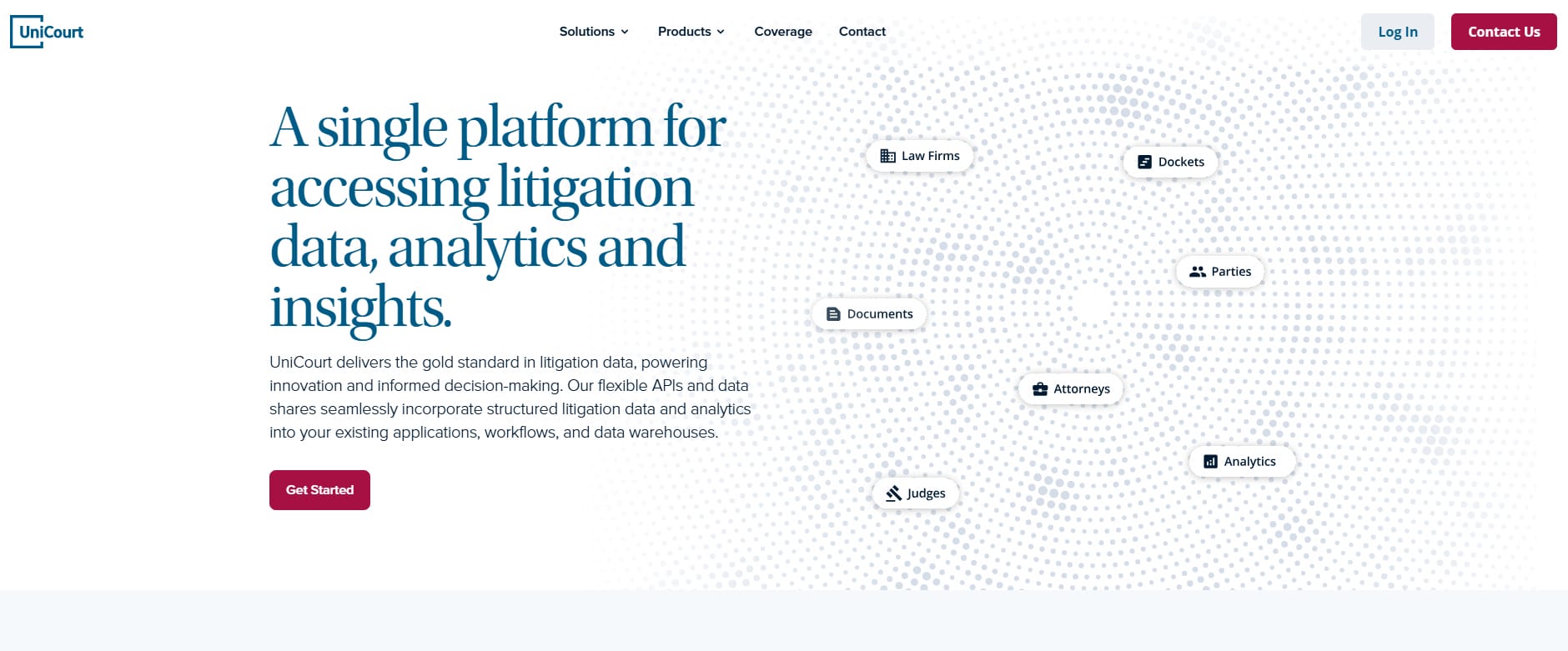
Source: UniCourt.com
The best feature of UniCourt is how it brings all kinds of legal data together under one roof. Whether you’re keeping tabs on a specific case, digging into legal precedents, or trying to spot trends in litigation, UniCourt lets you do it all without the need to jump between different databases.
Here are some of its key features:
- Automated court data access: Retrieves real-time case data from federal and state courts.
- Legal research & analytics: Provides AI-driven insights into case law, dockets, and litigation trends.
- Case tracking & alerts: Notifies users of case updates, filings, and procedural changes.
- API & data integration: Connects court records with legal and business intelligence platforms.
- Docket management: Centralizes court dockets for easy organization and access.
- Business & litigation intelligence: Identifies patterns in litigation, helping firms assess risks and opportunities.
- Document retrieval: Automates access to pleadings, motions, and other legal filings.
Aside from accessing data, UniCourt helps you manage it better. You can set up alerts to track cases automatically, so you’re always in the loop with real-time updates without constantly checking in manually.
Automate Discovery Drafting with Briefpoint.ai
Artificial intelligence is designed to eliminate the most tedious legal workflows. So, why not start with the most time-consuming tasks?
Briefpoint simplifies the process, cutting hours of manual work down to just minutes. With AI-powered automation, smart objections, and seamless client input collection through Briefpoint Bridge, your legal team can work faster and more efficiently—without sacrificing accuracy.
Stop spending valuable time on repetitive tasks. Try Briefpoint today and see how much time and money you can save. Schedule a demo now!
The Best Legal Technology Company for Discovery Documents
Discovery responses cost firms $23,240, per year, per attorney. $23,240 estimate assumes an associate attorney salary of $150,000 (including benefits – or $83 an hour), 20 cases per year/per associate, 4 discovery sets per case, 30 questions per set, 3.5 hours spent responding to each set, and 1800 hours of billable hours per year.
Book a demo and save on these costs with Briefpoint.
FAQs About Legal Service Providers
What is legal tech, and how does it benefit legal professionals and their clients?
Legal tech refers to the use of technology and software to provide legal services and support the operation of law firms and legal departments. Legal tech benefits legal professionals by streamlining workflows, reducing the time and cost associated with traditional legal processes, and enhancing the accuracy of legal documents and research.
For clients, legal tech can lead to quicker resolutions of legal matters, improved access to legal services, and, often, lower costs.
Can legal tech replace lawyers?
While legal tech software improves the efficiency and effectiveness of legal services, it is not designed to replace lawyers. Instead, it serves as a tool to assist lawyers in their work.
Technology can automate repetitive tasks and manage large volumes of data, but the nuanced judgment, ethical considerations, and client advocacy provided by human lawyers are beyond its current capabilities.
How is AI being used in legal tech, and what are its limitations?
AI in the legal industry is primarily used for automating document analysis, conducting legal research, predicting legal outcomes, and improving client service through chatbots and other interactive tools. It can sift through vast amounts of legal data to identify patterns, suggest relevant case law, and even draft legal documents.
How can legal drafting software benefit an international law firm?
Legal drafting software streamlines corporate and transactional issues by automating contract creation, compliance filings, and other essential documents. This reduces manual effort, ensures consistency across jurisdictions, and improves efficiency—ultimately freeing internal resources for higher-value legal work.
The information provided on this website does not, and is not intended to, constitute legal advice; instead, all information, content, and materials available on this site are for general informational purposes only. Information on this website may not constitute the most up-to-date legal or other information.
This website contains links to other third-party websites. Such links are only for the convenience of the reader, user or browser. Readers of this website should contact their attorney to obtain advice with respect to any particular legal matter. No reader, user, or browser of this site should act or refrain from acting on the basis of information on this site without first seeking legal advice from counsel in the relevant jurisdiction. Only your individual attorney can provide assurances that the information contained herein – and your interpretation of it – is applicable or appropriate to your particular situation. Use of, and access to, this website or any of the links or resources contained within the site do not create an attorney-client relationship between the reader, user, or browser and website authors, contributors, contributing law firms, or committee members and their respective employers.